David E. Grogan's Blog
November 19, 2025
Staff Sergeant Alfredo “Freddy” Rocha, U.S. Army (Retired) – 2 Iraqi Freedom Combat Deployments in a 20-Year Career
Military life is full of transitions. It begins with the transition from civilian to servicemember. Every two or three years thereafter, servicemembers and their families are uprooted from their homes, their jobs, and their schools to take new assignments, often far away in other countries. Sometimes military members must leave their peacetime assignments to deploy in times of war. Staff Sergeant Alfredo “Freddy” Rocha, U.S. Army (Retired), knows these transitions all too well. Two Iraqi Freedom combat deployments and two unaccompanied tours in South Korea tested Freddy’s ability to deal with transitions. With the help of others at every fork in the road, he navigated the course changes successfully.
Freddy was born in Orange County, California, in March 1977. He was a third-generation American, with his great-grandparents having emigrated from Mexico years before. Freddy’s father could not read or write, but he could work hard and work hard he did as a construction worker in the booming southern California economy. His mother worked hard, too, helping with programs distributing food stamps. Their motivation was clear—get the family out of poverty and into the middle class.
When Freddy was three, his parents moved their family to Norco, a city in Riverside County just west of Los Angeles. His home was typical of Mexican American households in the neighborhood at the time in that it was filled with cousins, other family members, and neighbors needing a place to stay. Freddy grew to love them all as family.
Unfortunately, gang activity was rampant in Freddy’s community, and his family was not immune. Some of his cousins were deep into gangs and many did serious time in prison. Freddy never joined a gang but always found himself on the fringe heading down the wrong path. This played out in his schooling when he was expelled from Norco High School during his freshman year. He had no intention of completing school anyway because one of his older brothers had dropped out and he saw how his father was able to earn a living by working hard. He knew, though, that he had to at least go through the motions until he was old enough to drop out for good.
Unable to return to Norco High, Freddy started attending the Corona-Norco Career Academy—an experimental high school designed to give kids who had gotten into trouble a second chance at their education. There Freddy excelled because he had the freedom to work more independently than in the structured environment of Norco High School. He still skipped school frequently and ran with the wrong crowd, but because he excelled at his schoolwork, no one tried to rein him in.
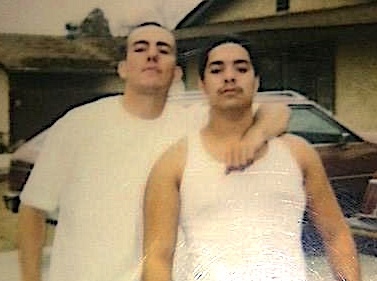 Freddy Rocha (right) with his lifelong friend, Johnny Canales (left)
Freddy Rocha (right) with his lifelong friend, Johnny Canales (left)Although Freddy never joined a gang, he and his best friend continued to get into trouble. Then Freddy started talking to a Vietnam veteran in his neighborhood, Steve Blunt. Blunt served in the special forces in Vietnam and was the first person to talk to Freddy like an adult. He leveled with Freddy and told him, “You’re f’ing up fast and picking up speed.” But what really impacted Freddy was when Blunt told him that if he continued down his current path, his actions would devastate his mother. Blunt then suggested Freddy consider the Army as a way to straighten out his life.
Blunt’s message resonated with Freddy. Motivated to change his life, he convinced a buddy to visit a recruiter with him in the fall of 1994. However, because Freddy was still seventeen, he needed both his parents to give their written permission to allow him to enlist. He told them he wanted to make a new life for himself, and the Army offered him the chance to do it. He also wanted to marry his high school sweetheart and that meant having a steady job that could transition into a career. By the time he finished speaking, he had convinced his parents, and they gave him their permission to enlist. Their only condition was he graduate from high school first.
Freddy did just that in the spring of 1995, graduating at the top of his class. He spent the summer enjoying a few more months of civilian life in southern California, painting houses and working at fast food restaurants to fund his fun. In the meantime, the buddy he had gone to the recruiter with was discharged from the Army for medical reasons. He told Freddy to get out of his commitment, saying Freddy would hate the Army because he didn’t like being told what to do. Freddy ignored his friend’s advice. He had given the Army his word he would enlist, and he intended to keep his promise.
True to his word, Freddy reported as directed to the Los Angeles Military Entrance Processing Station on August 23, 1994. There, he passed his final physical and took the oath of enlistment. Now officially in the Army, he boarded a plane the next day on his way to basic training at Fort Benning, Georgia.
Although Freddy’s plane landed in Atlanta late in the afternoon, the Army bus collecting new recruits for transport did not arrive at Fort Benning until 1:00 a.m. That’s when Freddy’s introduction to the Army and the South began. Everyone was directed to get off the bus and then escorted to the chow hall. There Freddy received a heaping helping of grits, which he had never tried before. He had eaten Cream of Wheat and Malt-O-Meal growing up, so he figured grits must be similar. Accordingly, he began to add butter and sugar to the grits. Out of nowhere, a recruit from West Virginia looked at him in disbelief and said with a strong southern accent, “What are you doing? You don’t put sugar on grits!” The experience made Freddy feel more Mexican than had ever felt in his life.
After a few hours of sleep, Freddy and the rest of the new recruits reported to the 30th Adjutant General Reception Battalion for in-processing. There they signed paperwork, received their uniforms, and got any shots they needed. They also learned their new training company assignments—Freddy’s was Delta Company of the 1st Battalion, 38th Infantry Regiment.
Freddy’s transition to Army life was rough. To begin with, he approached basic training with a chip on his shoulder. He hated being told what to do and initially did not get along with the other recruits. He saw them more as rivals rather than fellow trainees. Whenever there was a fight or even the hint of a fight among the recruits in his company, Freddy was involved. On the third night, he finally got “whooped” in a fight. The experience made him more tolerant of his peers.
The drill instructors were another matter—they scared Freddy. They were “big dudes” who got right in his face and screamed at him. On the streets back home, he never would have let anyone do that to him. Now it happened routinely. However, after Freddy started to make friends, things changed. He began to enjoy the training, even when he had to do extra pushups for laughing at other recruits when they did something wrong. Just as with high school at the Corona-Norco Career Academy, he excelled.
Freddy graduated from basic training on December 8, 1995. Next, he was scheduled to go to Airborne Jump School, where he would learn how to parachute out of airplanes. When he had enlisted, he’d committed to the airborne infantry, but he really didn’t know what it was at the time. Now that he did, he had a problem with it because he was afraid of heights. As all the new soldiers lined up for their respective follow-on training, Freddy stood with the infantry soldiers rather than with those heading to Jump School.
When a sergeant told Freddy to get in the Jump School line, Freddy told him he was afraid of heights. The sergeant didn’t want to hear it. So, after heading home on leave to Southern California to marry his high school sweetheart, Freddy returned to Fort Benning and began Jump School. Although at times his legs shook with intense fear, he successfully completed all his parachute jumps and graduated from the school. With Jump Wings now adorning his uniform, he received orders to report to the 82nd Airborne Division at Fort Bragg, North Carolina. From then on, it was “Airborne all the way.”
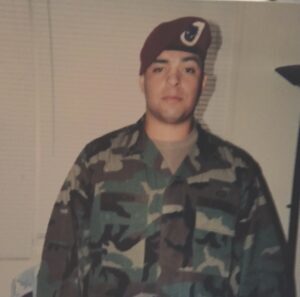 Private Freddy Rocha when assigned to the 82nd Airborne Division
Private Freddy Rocha when assigned to the 82nd Airborne DivisionFreddy arrived at Fort Bragg in February 1996. Because he was a new soldier fresh out of Jump School, the veterans subjected him and the other newly arriving soldiers to hazing. Freddy endured it all and became an integral member of the 82nd Airborne team. In April 1997, he deployed with his unit to Dharan, Saudi Arabia, where Khobar Towers had been bombed the year before. Freddy’s job was to provide security for a Patriot surface-to-air missile battery defending King Abdul Aziz Air Base. The deployment gave Freddy his first taste of an operational assignment outside the training environment, and he loved it. Even mundane tasks like donning his Mission Oriented Protective Posture (MOPP) gear, which is designed to protect soldiers from chemical and biological weapons, seemed exciting. He returned to Fort Bragg in August 1996 a motivated soldier.
Freddy made one additional deployment with the 82nd Airborne Division. This time it was to Belgium for training in early 2000. When he returned in March, he received orders to report to the 1st Battalion, 503rd Infantry Regiment, located at Camp Hovey in South Korea. Because the unit operated near the demilitarized zone (DMZ) between South and North Korea, Freddy could not take his family with him. This left his wife at home in charge of their two young children and their two older adopted children (a niece and a nephew). Knowing he would not see them again for a year, he said goodbye and boarded a plane for South Korea.
Although Freddy’s battalion was just fifteen miles from the heavily fortified DMZ and had to be always ready for a surprise attack from North Korea, his assignment proved uneventful until the day he was scheduled to depart. After celebrating the end of his tour with some buddies at bars in Seoul, he woke up in the barracks to his cell phone ringing. The call was from his wife asking him if he was going to war. Not knowing what had happened, he turned on the television and saw the second World Trade Center Tower being hit during the 9/11 terrorist attack on the United States.
Once word of the attack reached U.S. forces in South Korea, things moved quickly. Freddy’s unit, which had been exercising in the field without him, returned and Freddy was directed to immediately report to his defensive position with his weapon ready to repel any would-be attack. Unfortunately, he had already shipped all his belongings back to the States, including his uniforms and gear, because he had detached from his unit and was literally waiting to catch his flight home. Given the urgency of the moment, he hiked up the mountain to his defensive position carrying his weapon and live ammunition and wearing a t-shirt, flip-flops, cargo shorts, and a borrowed helmet. When his first sergeant saw him, he told him to get off the mountain, find a uniform, and get back into position ASAP. This Freddy did, and he found himself manning the position for eight days until things calmed down enough for him to return to the United States and rejoin his family.
Once back at Fort Bragg, Freddy received new orders to join Bravo Company of the 2nd Battalion, 3rd Infantry Regiment, at Fort Lewis, Washington. He reported on October 11, 2001—exactly one month after 9/11—and promoted to sergeant as soon as he arrived. His unit was part of the 3rd Stryker Brigade Combat Team. The Stryker was a new eight-wheeled armored vehicle with a crew of two and a troop compartment capable of carrying up to nine infantry soldiers. Freddy’s team was responsible for developing the tactics and standard operating procedures for deploying the Stryker with U.S. infantry units. That meant conducting training exercises to learn how to employ the vehicles with maximum effectiveness.
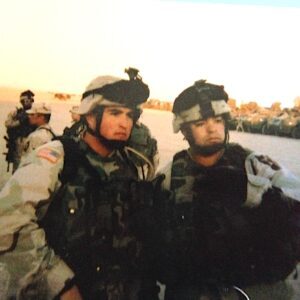 Freddy Rocha (right) in Iraq with one of his best friends, Jerry “Gonzo” Trejo (left)
Freddy Rocha (right) in Iraq with one of his best friends, Jerry “Gonzo” Trejo (left)Freddy’s situation changed when the Iraq War started in 2003. In November, he deployed in support of Operation Iraqi Freedom to Kuwait with Bravo Company as part of the 3rd Stryker Brigade Combat Team. He crossed with his company into Iraq in December to join the U.S. forces already in the country. The unit operated in northern Iraq, including in and around Mosul, employing the Stryker vehicle in combat operations for the first time. Freddy and the other members of his unit were tight and watched out for one another. In fact, his best friend, Gonzo, carried a photo of Freddy’s three-year-old daughter in his helmet because Freddy’s children were like family to him. Fortunately, Freddy’s company made it through the deployment without sustaining any casualties.
Freddy’s family was not as lucky. When he returned to Fort Lewis in August 2004, he and his wife separated and were divorced. Worse yet from Freddy’s perspective, his ex-wife was awarded custody of their kids. She did agree, though, not to move with the kids back to Southern California as long as Freddy was assigned at Fort Lewis. Seizing the opportunity, Freddy volunteered to stay with the 2nd Battalion, 3rd Infantry Regiment, for a second tour.
In June 2006, Freddy again found himself in Iraq as part of the 3rd Stryker Brigade Combat Team and Operation Iraqi Freedom. This time he was assigned to the battalion headquarters’ mobile operations center and was responsible for defending the center in the event of an attack. This happened on January 27, 2007, after an Apache attack helicopter was shot down in the vicinity of Najaf.
When Freddy’s Stryker arrived on scene and lowered its ramp so Freddy and the other soldiers onboard could disembark, they found themselves in the thick of a firefight with Hellfire missiles screaming into action nearby. Freddy’s unit quickly joined Charlie Company of the 2nd Battalion, 3rd Infantry Regiment, which was already in the fight, together with U.S. special operations forces and Iraqi Army soldiers, against hundreds of dug in Iraqi insurgents.
At one point after Freddy’s team set up the mobile operations center, Freddy heard the battalion commander radio the Charlie Company commander and ask for a situation report. The Charlie Company commander did not come to his radio. Instead, he could be heard shouting to his radio operator, “You tell him I’m in a firefight. I’ll update him when I can.” The fighting became so intense, Freddy promised God if he got out of it alive, he would quit smoking and marry his girlfriend. Enemy rockets flew everywhere while the special operations forces hammered away at the insurgents using a .50-caliber machine gun they salvaged from the downed helicopter. U.S. and British airpower joined the fight, and an AC-130 gunship devastated the insurgents with a barrage of fire from its rapid-firing cannons.
As the battle went on, Freddy’s sergeant major asked for help treating the wounded. Freddy volunteered because he had taken an emergency medical technician (EMT) course before the deployment. He grabbed a first aid kit and started to help, but he wasn’t prepared for the injuries he saw even though he’d seen casualties before and had not been affected by them. He collected himself by remembering he had a reputation to protect for being a tough soldier. Once he felt back in control, he returned to rendering aid.
The thirty-six-hour battle of Najaf was the fiercest action Freddy faced in Iraq, but other tough situations lay ahead. He lost a total of nineteen comrades during his brigade’s fifteen-month deployment, including some killed when improvised explosive devices destroyed the vehicles they rode in. Even Freddy was injured in a vehicle rollover accident.
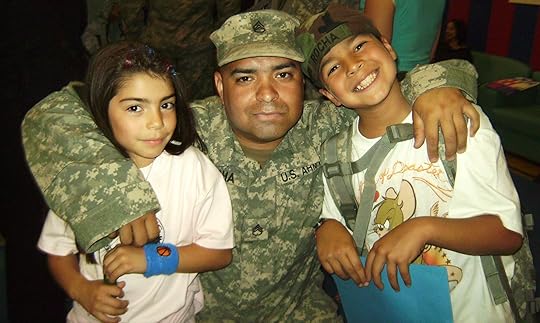 Staff Sergeant Freddy Rocha with his daughter, Aleina, and his son, Fredo, when he returned from his second Iraq deployment
Staff Sergeant Freddy Rocha with his daughter, Aleina, and his son, Fredo, when he returned from his second Iraq deploymentWhen the 3rd Stryker Brigade Combat Team finally returned to Fort Lewis in September 2007, it received a hero’s welcome. Freddy’s girlfriend, his parents, and his children were all on hand to welcome him home and watch Freddy’s unit march by. It was the first time Freddy’s father had seen him in uniform, and it made Freddy feel proud.
Still, Freddy was tired. He’d been in the Army for twelve years and spent much of that time deployed, including twice to Iraq. So, when it came time to reenlist, Freddy asked for orders to a command at Fort Lewis that would not deploy. He also requested the colonel of the 2nd Battalion, 3rd Infantry Regiment, administer his reenlistment oath. Both the colonel and Freddy found that funny because the colonel had “busted” Freddy in rank twice at Article 15 nonjudicial punishment proceedings while they were deployed in Iraq. But the colonel knew Freddy was a good soldier and believed in him, so he was happy to help Freddy reenlist. He also congratulated Freddy for surviving Iraq and for continuing with his Army career.
For the next three years, Freddy was assigned at Fort Lewis to Charlie Company of the 1st Battalion, 357th Infantry, training National Guard units to deploy. On the job, he specialized in teaching short-range marksmanship. Off the job, he rehabilitated injuries he’d received overseas, got married, and earn his bachelor’s degree.
In March 2011, Freddy received orders to return to South Korea, this time as a platoon sergeant for one of two infantry companies assigned to the 1st Battalion, 72nd Armored Regiment, at Camp Humphreys. The concept was for the infantry companies, operating with their Bradley Fighting Vehicles, to learn to fight side-by-side with the tanks of the 72nd Armored Regiment. Freddy found the experience professionally rewarding and challenging. He motivated the soldiers in his platoon by reminding them they were training on ground fought for and won by the blood of U.S. soldiers during the Korea War just sixty years before.
Freddy returned to Fort Lewis in March 2012. At the request of his former battalion commander, he again took a job with the 1st Battalion, 357th Infantry, thinking it might be his last tour. He’d been tired ever since the battle of Najaf and was still having trouble dealing with his experience in Iraq. He tried to present an image of being a tough staff sergeant. After all, he’d been in combat and had earned the Expert Infantryman badge. But now, for his own well-being, he knew he had to change direction and find a job that involved helping people. His initial thoughts were to become a nurse. He just needed a sign before deciding to part company with the Army and retire. That sign came when he did not make sergeant first class.
Freddy officially retired on September 1, 2015, after serving twenty years and seven days on active duty. He then followed through on his goal of becoming a nurse by going to school to become a Certified Nursing Assistant. As part of his studies, he took a job at a nursing home to gain some practical experience. That experience taught him a nursing career would not be a good fit for him.
The transition to civilian life continued to prove difficult. All his life, he’d been an infantryman, and now that he was retired, suddenly everything he knew and valued was gone. A friend of his set up a meeting for him with a woman at the local Veterans of Foreign Wars (VFW) post and the woman asked him to bring his medical record. After the meeting, she helped him file a disability claim, which at the time he really didn’t understand. In fact, he felt like he was spiraling out of control. He visited the gravesite of one of his best friends killed in Iraq. He’d not attended any ceremonies honoring his fallen comrades in the past, suppressing any emotions he had by focusing on the mission at hand. Now it all came crashing down and he questioned how he could go on. He thought no one cared.
The turning point came one day when his car overheated. By chance, he pulled into the parking lot of VFW Post 2224 in Puyallup, Washington, and went inside to ask if he could use a hose to add water to his radiator. Carlos Alameda offered to help, and they began to talk. Immediately, Freddy knew Carlos understood him and what he was going through. Carlos invited Freddy to learn more about the VFW’s programs and showed him ways he could start helping other people through the VFW. It was just the medicine Freddy needed. Soon, the friendships he made at the Post started to fill the void he felt after leaving the Army. He felt like he had a purpose again.
Even after Freddy found the VFW, his life wasn’t all smooth sailing. It was, however, on the right trajectory. Although he divorced again in 2017, he remained on good terms with his ex-wife. Then, after his youngest daughter graduated from high school in June 2018, he moved to Springfield, Illinois. There he earned his master’s degree and accepted a position with the University of Illinois Springfield as an admissions counselor. He later transitioned to the Illinois Department of Veterans Affairs as a full-time veteran service officer. Essentially everything Freddy now does centers around helping veterans and their families, and that is just the way he wants it.
Voices to Veterans is proud to salute Staff Sergeant Alfredo “Freddy” Rocha, U.S. Army (Retired), for his twenty years of distinguished service to our country. Freddy willingly went wherever the Army needed him most, including two unaccompanied tours to South Korea and two combat deployments to Iraq. After successfully accomplishing all the Army asked of him, he returned to civilian life where he now devotes his time and energy to helping veterans and their families succeed. We thank him for all he has done and wish him fair winds and following seas.
If you enjoyed Freddy’s story, please sign up for the Voices to Veterans Spotlight monthly newsletter by clicking here. Once each month, you’ll receive a new written veteran’s story directly in your mailbox. Best of all, it’s free and you can unsubscribe at any time.
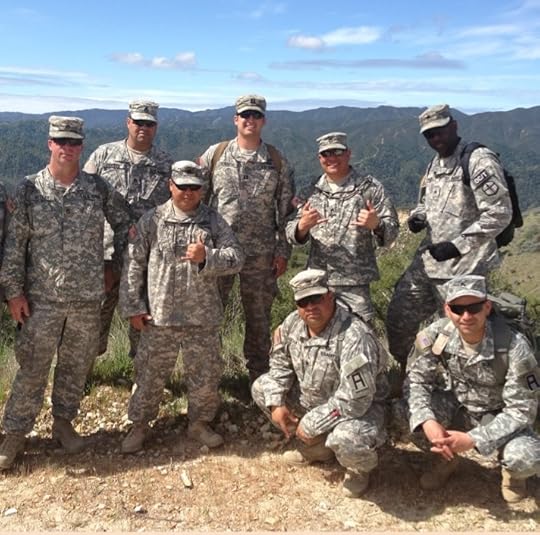 Staff Sergeant Freddy Rocha (second from right on first row) with other soldiers from the 1st Battalion, 357th Infantry
Staff Sergeant Freddy Rocha (second from right on first row) with other soldiers from the 1st Battalion, 357th Infantry The post Staff Sergeant Alfredo “Freddy” Rocha, U.S. Army (Retired) – 2 Iraqi Freedom Combat Deployments in a 20-Year Career first appeared on David E. Grogan.
October 15, 2025
Radio Telegraph Operator Second Class Leon Schiff, U.S. Merchant Marine – A Will to Serve During World War II
After the United States entered World War II, the American public rallied behind the war effort. Everyone contributed by recycling metals, accepting shortages of consumer goods so war materials could be produced instead, and buying war bonds. Even more significant, millions of men volunteered to serve in the armed forces. Yet not all who wanted to serve in the military could. Some had crucial jobs in agriculture and industry, so they could not be released to serve. Others like Radio Telegraph Operator Second Class Leon Schiff faced different barriers. Leon was so nearsighted, the military would not allow him to volunteer. Undeterred and committed to doing his part to bring about the defeat of Germany and Japan, Leon volunteered in 1944 to serve in the U.S. Merchant Marine—an underappreciated yet crucial component of the Allied victory in the war.
Leon was born in East Boston, Massachusetts, in 1925. He was the youngest of ten children and the son of a butcher. His father immigrated to the United States from England in 1903 after the London smog started causing him health problems. He sent for Leon’s mother and three older brothers in 1905 after he established himself in Boston and saved enough money for their passage. Leon’s remaining six brothers and sisters were quite literally born in their new home in the United States—Leon was the first and only one of the siblings born in a hospital.
After completing the ninth grade, Leon attended East Boston High School for his sophomore through senior years. Instead of gym class, he and the other boys participated in troop training. They even donned surplus World War I uniforms and joined boys from other schools marching through Boston to demonstrate their martial skills. Outside of school, Leon worked as a “soda jerk” at local pharmacy stores owned by his older brothers. During the summers, he took his skills to Winthrop and Revere Beach, where he worked with other boys serving soft drinks to people in dance halls taking refreshment breaks between songs.
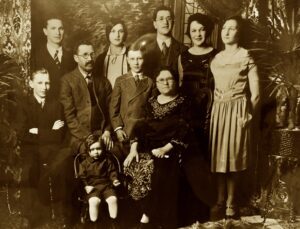 Leon Schiff (small boy in bottom center) with his parents and seven of his brothers and sisters
Leon Schiff (small boy in bottom center) with his parents and seven of his brothers and sistersLeon turned seventeen in May 1942 and graduated from high school the following month. With the nation mobilizing in the wake of the Japanese attack on Pearl Harbor just seven months before, Leon’s first inclination was to enlist in the military. Unfortunately, he was very nearsighted, so the Army, Navy, and Coast Guard could not accept him. Upset but not discouraged, Leon attended Temple University in Philadelphia during the fall of 1942 and the spring of 1943 before hitchhiking to Canada to join the Canadian army to get into the fight. Again, he was thwarted because he did not want to risk losing his U.S. citizenship by taking an oath to Canada in order to enlist. Accordingly, he returned to Temple University for the 1943–44 academic year.
In the spring of 1944, Leon learned there was another way he could serve—the U.S. Merchant Marine. Merchant Marine civilian mariners manned the ships carrying millions of tons of supplies across the submarine-infested Atlantic and Pacific sea lanes to where they were needed most by the Allied forces fighting Germany and Japan. Closer to home, they manned the coastal freighters transporting goods between U.S. ports, always subject to the danger posed by German U-boats hunting them off America’s east coast.
Leon applied to the Merchant Marine in the late spring of 1944 and was accepted. He reported for boot camp at the U.S. Maritime Service’s training station at Sheepshead Bay in Brooklyn, New York, immediately adjacent to the Coast Guard training station at Manhattan Beach. There he learned the basics of seamanship, including tying knots, ship driving, navigation, engineering, and cargo handling. He also took aptitude tests to see what positions he might be best suited for, such as cook, baker, engine room wiper or oiler, steward, hospital corpsman, or radio operator.
Based on Leon’s test results, he was selected to train as a radio operator. Accordingly, after completing boot camp, he and the other radio operator selectees were transferred to Gallops Island in Boston Harbor to attend radio operator school for twenty weeks. During the first week, Leon’s platoon of twenty men was assigned drudge work like cooking, cleaning, disposing of garbage, and performing other similar tasks. After a week of paying their dues, they began their formal radio operator training, joining two other platoons that had been training there for some time.
The schedule at Gallops Island was rigorous. Reveille woke Leon at 6:00 a.m. every weekday, followed by breakfast and exercise. Classes in radio theory and Morse code began at 8:00 a.m. and continued until 4:00 p.m., with a one-hour break for lunch. Every Friday, Leon and his classmates were tested on the week’s course material. If they failed, they repeated the week’s courses and retook the test at the end of the next week. If they failed a second time, they were dropped from radio operator training and returned to boot camp at Sheepshead Bay. To keep that from happening, the men helped each other learn the material in study sessions after the end of each workday. As a result, few failed the weekly tests.
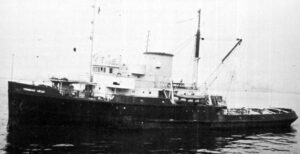 The Sands Point was a powerful V4-M-A1 tug built in 1943. This photo is of the Trinidad Head, a similar V4-M-A1 tug. Source: U.S. Navy
The Sands Point was a powerful V4-M-A1 tug built in 1943. This photo is of the Trinidad Head, a similar V4-M-A1 tug. Source: U.S. NavyLeon was fortunate in that he excelled in both the radio theory course material and Morse code. Of the two, learning Morse code was more difficult because it was a skill some men had a knack for, and others didn’t. To successfully complete the training and earn his Federal Communications Commission (FCC) Second Class Radio Operator’s License, Leon had to be able to transmit and receive thirty words per minute, where a word consisted of a group of five short signals of light or sound. Leon caught on quickly because he recognized a rhythm in the transmissions, allowing him to increase his Morse code speed every week. He also had good role models in his instructors, who could send and receive up to sixty words per minute, so Leon knew thirty words per minute was certainly achievable.
By about the fifteenth week of the training, Leon had mastered the radio theory material and could send and receive over thirty words per minute in Morse code. Accordingly, he asked to take the next Monday off so he could take the Second Class Radio Operator’s License exam at the FCC office in Boston. When his instructors denied his request, Leon took matters into his own hands. The following Friday, he took the liberty boat to Boston and instead of returning to Gallops Island on Sunday morning as he was required to do, he stayed in Boston and took the FCC licensing exam on Monday. He then returned to the island on Monday afternoon.
Although Leon passed the exam and earned his Second Class Radio Operator’s License, he had defied his instructors and had to be held accountable. Accordingly, he was disciplined at an administrative procedure known as captain’s mast. His sanction was he had to take additional classes at night after the workday had ended, but Leon considered this a small price to pay now that he had his FCC license in hand.
Leon’s timing could not have been better. With the end of World War II on the horizon, the U.S. Maritime Service stopped sending radio operator trainees to Gallops Island. Leon and the other students were then transferred first to the radio operator training facility on Hoffman Island, near Staten Island, New York, and then back to the main training facility at Sheepshead Bay in Brooklyn. An announcement followed that all radio telegraph operator trainees would be transferred to ships to serve as messmen, but Leon objected. He argued that since he already had his FCC license, he qualified to be assigned as a radio telegraph operator second class, which would make him a junior officer rather than an unlicensed seaman. The training staff agreed and, in May 1945, sent him to New Orleans shortly after Victory in Europe (VE) Day. There he joined the crew of the 186-foot seagoing tug Sands Point. The tug, which was built for the U.S. Navy in 1943 and operated by the Moran Towing Company under contract, had a crew of eighteen. As a radio telegraph operator second class, Leon was one of five officers onboard. The others were the captain, the first mate, the chief engineer, and the first assistant engineer.
As the Sands Point’s radio telegraph operator, Leon had his own stateroom, located immediately behind the tug’s radio room. This allowed him to be ready to send or receive radio messages at any time of the day or night, even when he wasn’t on watch. He also had to maintain the radio’s six large batteries, which powered the generator that ran the tug’s radio. Despite these responsibilities, Leon was called upon only three times to use his hard-earned Morse code skills. The most notable time involved the captain calling him to the pilot house to decipher a message a U.S. Army transport ship was sending using a flashing light. When Leon decoded the signals, he learned the crew of the Army transport did not know what their position was and was asking the Sands Point to tell them where they were. After Leon answered by providing the Army transport’s position, the Sands Point continued on its way.
Aside from the infrequent radio telegraph responsibilities, Leon’s principal duties involved standing watch in the tug’s pilot house and assisting the rest of the crew accomplish the tug’s towing missions. These missions primarily involved assisting tankers experiencing problems in the Gulf of Mexico as they ferried oil from Venezuela to the United States. The Sands Point rendezvoused with them wherever they broke down and towed them to a U.S. port on the Gulf Coast for repairs.
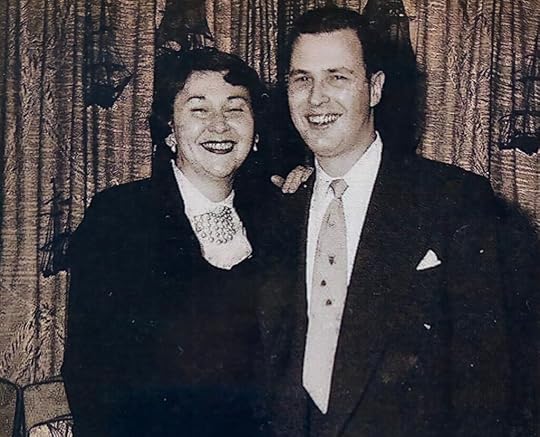 Leon and Eileen Schiff
Leon and Eileen SchiffLater that year, Leon and the Sands Point relocated to Galveston, Texas. In addition to continuing with its previous towing duties, it began making trips to the Wainwright Shipyard in Panama City, Florida, where it picked up new tankers that were no longer needed now that World War II was over. The Sands Point towed these tankers to Beaumont, Texas, and pushed them onto the mud flats for storage. The tankers were later sold at auction for pennies on the dollar to businessmen like Aristotle Onassis, who used them to build his postwar shipping empire.
Another postwar mission of the Sands Point involved towing cargo ships loaded with World War II surplus aircraft and vehicles into the deepwater areas of the Gulf of Mexico. Rather than selling the surplus items in the United States where they would flood the market, the U.S. government disposed of the items by shoving them overboard into the deepest part of the Gulf. The empty cargo ships were then towed to Beaumont’s mud flats, where they joined the tankers waiting to be auctioned off to the highest bidders.
Unlike on most ships, one highlight of life on the Sands Point was the food. Sometimes when the tug left Galveston, the cook would throw a net overboard to catch enough shrimp to feed the crew. Other fresh seafood was also plentiful, as were bacon and eggs and other staples. Even better, meals were available twenty-four hours a day. Aside from the food, Leon enjoyed sunning in the former gun mount tub on top of the pilot house and studying to become a pharmacist in hopes of following in his brothers’ footsteps. Rounding out his experience at sea, Leon only got seasick once when the tug rode out a hurricane in the deep water of the Gulf of Mexico. He felt sorry for the seamen that had to clean up the mess.
At the end of December 1945, Leon decided that since the war was over, it was time to go home. He returned to Boston and to his job working for his brothers at their pharmacies. He also took some pharmacy courses to prepare for the pharmacy exam. In 1947, his studying paid off when he passed the pharmacy exam and became a licensed pharmacist. That same year, he married, Eileen, his wife of sixty-three years before she passed away. Together they had a son, Jeff, and two daughters, Nancy and Lisa. Leon also eventually bought his brothers’ pharmacies and expanded to more locations in Boston until he finally got out of the pharmacy business in 1981. Now he is retired and living with one of his daughters on the Atlantic coast northeast of Boston.
Voices to Veterans is proud to salute Radio Telegraph Operator Second Class Leon Schiff for his service in the U.S. Merchant Marine during World War II. Undeterred when doors closed to service in the military, Leon volunteered to serve on the ships supplying U.S. and Allied forces worldwide in their efforts to defeat the Axis. After many months of training, his service took him to the Gulf of Mexico, where he assisted ships at risk and enabled the U.S. postwar drawdown. We thank him for his service and wish him fair winds and following seas.
If you enjoyed Leon’s story, please sign up for the Voices to Veterans Spotlight monthly newsletter by clicking here. Once each month, you’ll receive a new written veteran’s story directly in your mailbox. Best of all, it’s free and you can unsubscribe at any time.
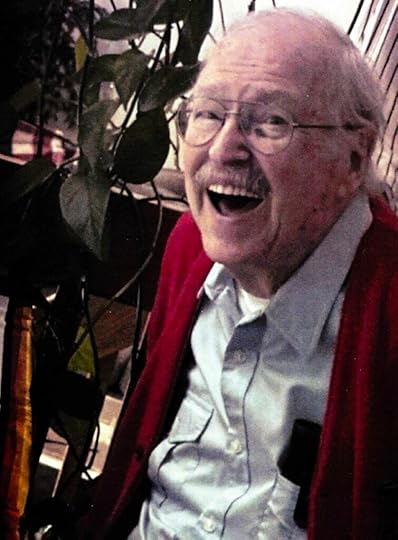 Leon Schiff
Leon Schiff The post Radio Telegraph Operator Second Class Leon Schiff, U.S. Merchant Marine – A Will to Serve During World War II first appeared on David E. Grogan.
September 10, 2025
Petty Officer Third Class Kimberly Yantis, U.S. Navy: Deploying on USS Boxer – “You Call, We Haul”
Every servicemember knows the GI Bill is a great way to help pay for an education. The benefits, however, are hard earned, sometimes involving long periods away from home and even deployments into harm’s way. Such was the case with Petty Officer Third Class Kimberly Yantis, U.S. Navy, who enlisted with a goal of using the GI Bill to help pay for her bachelor’s degree. She earned her benefits by participating in two deployments supporting Operation Iraqi Freedom and one to the Western Pacific, all the time working in extremely dangerous conditions on her ship’s flight deck. Now she channels her experience into her lifelong passion of helping veterans and their families in Central Illinois.
Kimberly was born in Springfield, Illinois, in 1983. She was the youngest of her parents’ three children and the only girl. She attended Southeast High School and spent her free time waitressing at local restaurants as soon as she turned sixteen. She also focused on her studies, qualifying her to graduate in December 2000, although she participated in the June 2001 ceremony with all her classmates who were on the normal graduation timeline.
After high school, Kimberly enrolled at Lincoln Land Community College and began taking classes in the fall. To help pay for books and tuition, she waitressed at Smokey Bones Bar & Fire Grill and worked a second job as a temporary employee for the Illinois Department of Family and Child Services. Her goal was to earn her bachelor’s degree, but her family could not afford it. Accordingly, in the spring of 2002, she looked to the Navy and the educational benefits it offered to help her achieve her goal.
Kimberly enlisted in the Navy’s Delayed Entry Program, which allowed her to continue working in Springfield until her active-duty report date in November 2002. When that date arrived, she took a bus to the Military Entrance Processing Station in St. Louis, where she passed her final physical and raised her right hand, swearing to support and defend the Constitution. Then, together with other new Navy recruits, she flew to Chicago to begin boot camp at Recruit Training Command Great Lakes, located just north of the city.
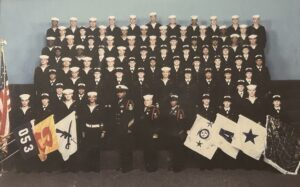 Kimberly Yantis’ company at boot camp. Kimberly is fourth from the left in the second full row from the bottom.
Kimberly Yantis’ company at boot camp. Kimberly is fourth from the left in the second full row from the bottom.Boot camp lived up to its reputation. As soon as Kimberly and the others got off the bus from Chicago’s O’Hare Airport, petty officers started screaming at them and getting in their faces. Kimberly was prepared for that, even cutting her hair short in anticipation of the stress-filled in-processing. Not satisfied, the Navy barbers chopped away at her hair anyway, making sure she did not miss out on the full recruit experience.
Despite the rigorous training schedule, Kimberly excelled. At nineteen, she was in good physical shape, so she did not find the running and other physical training difficult. Swimming, however, posed a bigger challenge. She and her fellow recruits spent a lot of time in the water learning the swimming and survival skills they needed to know but hoped never to use. On the positive side, Kimberly found the food good, especially since she was always hungry from all the physical activity and had limited time to eat her meals.
Two specific aspects of boot camp proved difficult. First, on Christmas Eve 2002, Kimberly had her wisdom teeth extracted. While the procedure ensured she would not have any problems with those teeth while deployed on a ship where a dentist might not be readily available, it made for an unpleasant holiday where she could only eat soft foods. Second, the ramp-up during the last week of boot camp was intense, preparing the recruits for their final training event. During this event, they had to stay up all night employing the swimming, firefighting, and other skills they learned during their eight weeks of training. After Kimberly passed the event, she felt ready for her first assignment on a ship at sea, which she already knew would be the USS Boxer (LHD-4).
With her parents in attendance, Kimberly graduated from boot camp on January 17, 2003. That same day, the USS Boxer deployed from San Diego on its way to the Persian Gulf carrying over 1,500 Marines and their equipment. Before Kimberly could join the ship, however, she had to complete airman apprentice training at the Naval Air Technical Training Center (NATTC) in Pensacola, Florida. At NATTC, Kimberly learned the skills she would need for her assignment as an undesignated airman apprentice onboard the Boxer—a ship with an 844-foot flight deck from which helicopters and AV-8B Harrier jets could take off and land. Kimberly was considered “undesignated” because she had not yet been assigned a career field, or rating in Navy parlance. Accordingly, NATTC taught her the basic skills she would be expected to perform working on the flight deck of a ship. These skills included placing chocks under the wheels of helicopters and tying the aircraft down with chains, all the time with the helicopters’ rotors whirring above her head. She also received extensive firefighting training because fires onboard Navy ships loaded with aviation gasoline and ordnance could prove deadly if not quickly brought under control.
Kimberly completed her training at NATTC in February 2003 and went home to Springfield for some well-deserved leave. She coupled her leave with recruiting duty, which gave her some additional time at home. Then, it was off in March to the Boxer’s homeport in San Diego, where arrangements were made to fly her to the United Arab Emirates so she could meet the Boxer in the Persian Gulf. This she did in March 2003, shortly after the U.S. military and its allies commenced combat operations in Iraq on March 20 as part of Operation Iraqi Freedom. Kimberly and other sailors heading to the Boxer then helicoptered out to the ship, staying on an intermediate ship for a day en route. When they finally arrived onboard Boxer, it was operating off the coast of Kuwait.
Because USS Boxer was Kimberly’s first ship and the ship was involved in a war, she had to quickly acclimate to her new life at sea. As she expected, she was assigned to the Air Department, where she would work on the flight deck handling helicopters shuttling Marines and their equipment to and from the shore. Before she could do that, though, she had to pay her dues by working in the ship’s galley for ninety days, something all new junior enlisted sailors were expected to do. In the galley, she served food to other enlisted sailors and did general kitchen duties until her time was up. Then she reported back to the Air Department to begin working on the flight deck.
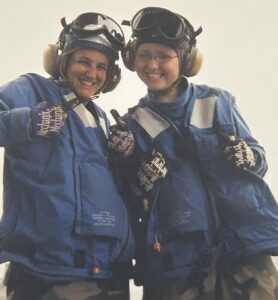 Kimberly Yantis (right) and another sailor wearing their blue shirt gear on USS Boxer
Kimberly Yantis (right) and another sailor wearing their blue shirt gear on USS BoxerWith helicopters landing and taking off, high winds blowing over the flight deck, and the Persian Gulf’s extreme heat, working on the flight deck was extremely dangerous. To ensure Kimberly learned her new responsibilities safely, she began by shadowing an experienced “blue shirt”—a sailor wearing a blue turtleneck shirt whose responsibilities included chocking and chaining H-60 Seahawk and CH-53 Sea Stallion helicopters to the Boxer’s flight deck. Initially, Kimberly followed right behind her mentor, learning everything she needed to do around the helicopters. Once she had enough experience, she swapped positions with her mentor, and he followed behind her as she accomplished all the tasks he had formerly done. When Kimberly mastered all the tasks, she split duties with her mentor, with her mentor handling the far side of the helicopter and Kimberly handling the near side. After her mentor completed his work on the far side, he checked Kimberly’s work before signaling to the supervisory sailor wearing a yellow turtleneck that all was done. After about one month, Kimberly was on her own, a fully trained “blue shirt” responsible for safely handling helicopters on Boxer’s flight deck.
In late April, Boxer pulled into Jebel Ali in the United Arab Emirates to give the crew a week-long break. The break, though, was limited to an area on the pier known as “the sandbox,” where Kimberly and the rest of the crew could buy food and shop for souvenirs. Although it wasn’t as fun as touring an exotic port city, it was time off the ship and away from the grueling 24/7 operations at sea, which everyone appreciated. Afterwards, Boxer resumed her station in the northern Persian Gulf.
Near the first of July 2003, it came time for Boxer to head home to San Diego. On the way, the ship made port calls in Townsville and Sydney, Australia, giving Kimberly the opportunity to get off the ship and visit each city for a few days. The visit to Australia also meant she crossed the equator for the first time—a significant event in her career as a sailor. To mark the occasion, she participated in a “crossing the line” ceremony, where she transitioned from an untested “pollywog” to a “trusty shellback.” Because she also crossed the international date line at the same time, she earned the further distinction of being a “golden shellback.” She still has the certificate signed by Davey Jones and King Neptune recognizing her achievement.
USS Boxer returned to San Diego on July 26, 2003, and Kimberly’s mother welcomed her on the pier after she got off the ship. Under normal circumstances, the ship would have entered a reduced operational period to allow for post-deployment maintenance to be completed and the crew to spend some time with their families before beginning the next deployment cycle. However, with the Iraq War continuing, Boxer immediately began preparing to again deploy to the Persian Gulf.
On January 14, 2004—just six months after returning from its last deployment—Boxer again deployed with Marines from Camp Pendleton onboard in support of Operation Iraqi Freedom. The quick turnaround to transport the Marines to Iraq after the 2003 deployment validated the crew’s slogan for the ship, “You call, we haul.” Kimberly, now an experienced airman, continued with her blue shirt responsibilities on the flight deck across the Pacific Ocean and into the Persian Gulf. She also assumed new administrative responsibilities, helping her division’s chiefs process training and qualification documentation in anticipation of an upcoming inspection. The highlight of the deployment was Boxer’s port calls to Singapore; Goa, India; Sasebo, Japan; and Dubai, United Arab Emirates.
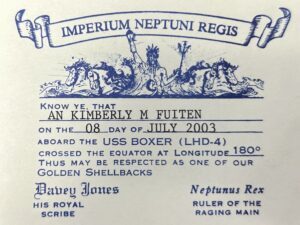 Kimberly Yantis’ Golden Shellback certificate
Kimberly Yantis’ Golden Shellback certificateKimberly and the Boxer arrived back in San Diego on April 29, 2004. Expecting a more relaxed schedule having just completed two deployments to the Persian Gulf in less than eighteen months, Kimberly invited her brother, Mike, to live with her in San Diego. This worked well until Kimberly learned the Boxer was going to deploy yet again, this time to the Western Pacific, in April 2005. To prepare, Kimberly and the rest of the crew painted and performed maintenance on their spaces, making sure the ship was ready to deploy yet again. In addition, the ship spent time at sea maneuvering off the coast of California and conducting flight operations and beach assaults with embarked Marines. When departure time finally arrived, Mike returned to Springfield and Kimberly boarded the ship for her third deployment.
USS Boxer departed San Diego on April 29, 2005, heading west toward Sasebo, Japan. Kimberly was now a yellow shirt on the flight deck, supervising blue shirts handling the aircraft and communicating directly with the helicopters’ pilots. In addition, she had promoted to petty officer third class and was designated an Aviation Boatswain’s Mate (Handling), together abbreviated ABH3. Despite these achievements, Kimberly’s deployment ended in Sasebo in May when she learned she was pregnant. The ship transferred her ashore and she flew back to San Diego, where she completed her four-year enlistment as an ABH3 with Helicopter Anti-Submarine Squadron 10 (HS-10). She was honorably discharged in November 2006.
After the Navy, Kimberly returned to Springfield, Illinois, to pursue her bachelor’s degree. Using the GI Bill, the Illinois Veterans Grant, and other benefits, she enrolled at Lincoln Land Community College and began taking classes in January 2007. Then in the fall, she enrolled at the University of Illinois Springfield, where she earned not only her bachelor’s degree in social work, but also her master’s degree in human services. She is currently working on a second master’s degree in public administration.
At the same time she was pursuing her degrees, Kimberly also worked full time. She began in October 2007 at the Sangamon County Veterans Assistance Committee (VAC), starting out as a clerk and transitioning to veterans service officer. Three years later, she left the VAC to become a veterans service officer for the Illinois Department of Veterans Affairs, only to return to the VAC in October 2011 to serve as its superintendent. She continued in this role until early 2020, when she went back to the Illinois Department of Veterans Affairs, where she serves as the central region supervisor.
Beyond her day job, Kimberly started her sixth year as the commander of Chatham-Auburn Memorial Veterans of Foreign Wars (VFW) Post 4763 on July 30, 2025. She is the first woman to serve in the role and loves that she can continue serving the veteran community through her VFW post.
Voices to Veterans is proud to salute Aviation Boatswain’s Mate (Handling) Third Class Kimberly Yantis for her wartime service in the U.S. Navy. Kimberly participated in three USS Boxer deployments, two of which took her into the Persian Gulf during Operation Iraqi Freedom where she worked on the flight deck helping Marines get into the fight ashore. She then returned to civilian life in Springfield, Illinois, where she has served veterans in both her professional and personal capacities ever since. We thank Kimberly for all she has done and wish her fair winds and following seas.
If you enjoyed Kimberly’s story, please sign up for the Voices to Veterans Spotlight monthly newsletter by clicking here. Once each month, you’ll receive a new written veteran’s story directly in your mailbox. Best of all, it’s free and you can unsubscribe at any time.
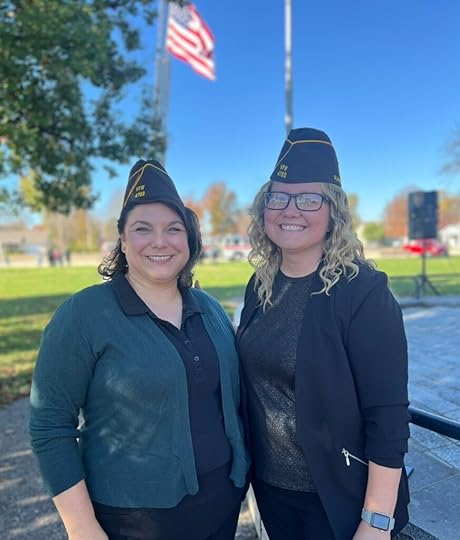 Chatham-Auburn VFW Post 4763 Commander Kimberly Yantis (right) with Adjutant Stephanie Wells (left)
Chatham-Auburn VFW Post 4763 Commander Kimberly Yantis (right) with Adjutant Stephanie Wells (left) The post Petty Officer Third Class Kimberly Yantis, U.S. Navy: Deploying on USS Boxer – “You Call, We Haul” first appeared on David E. Grogan.
August 20, 2025
Lieutenant Commander Thomas M. Dean, Jr., U.S. Navy (Retired) – Patrolling the Skies and the Seas to Keep Us Safe
Most of us work over forty years before retiring. Devoting that length of time to our careers makes finding a job we enjoy important. For some, it can take years of trial and error in different fields before finding the right fit. For Lieutenant Commander Thomas M. Dean, Jr., U.S. Navy (Retired), the answer became clear long before he entered the workforce—he needed to be part of naval aviation. Getting there required hard work and dedication, but, once he achieved it, naval aviation brought him a lifetime of happiness, especially through the many outstanding people he met and worked with.
Tom’s father, Thomas M. Dean, Sr., enlisted in the Navy in October 1940 and was at Pearl Harbor when the Japanese attacked on December 7, 1941. During the war, he flew in Navy patrol aircraft in the Pacific theater. Afterwards, he stayed in the Navy and took an assignment at Naval Air Station Jacksonville, Florida, where he met Helen “Bonnie” Perelli. Bonnie’s fiancée, the radio officer on the troop transport SS Dorchester, had been killed in 1943 when a German U-boat torpedoed and sank the ship. After his death, Bonnie moved from Philadelphia to Jacksonville to work in an aircraft factory and start her life over. Then she fell in love with Tom Sr., and they married in January 1945. They had their first child, Joan, in 1947.
The couple’s second child, Tom Jr., was born in 1958 when Tom Sr. was assigned as the maintenance chief for VF-124, a Navy fighter squadron based at Naval Air Station Miramar in San Diego, California. A year later, the family moved to Monroe, Louisiana, where Tom Sr. served for three years as a Navy recruiter. From there, they moved to Naval Air Station Patuxent River, Maryland, where Tom Sr. worked on a new type of long-range anti-submarine and reconnaissance patrol aircraft called the P-3 Orion. When Tom Jr. was four years old, he went with his dad to work and got to go on one of the new four-engine turboprop P-3s, where even the smell of the big airplane seemed inviting to him. Thus began Tom Jr.’s lifelong love of naval aviation.
In 1965, Tom Sr. moved the family to Naval Air Station Memphis in Millington, Tennessee, for his final tour. He retired there in 1970 as a master chief petty officer, the Navy’s highest enlisted rank, having served for thirty years. After he retired, the family stayed in Millington, which is where Tom Jr. (hereafter “Tom”) grew up and called home.
Tom attended Millington Central High School. He broke his leg during his sophomore year, which kept him out of most outside activities, especially sports. Once he recovered during his junior year, he began working at a local veterinary clinic, where the supervising veterinarian let him get involved in all aspects of animal care, including lab work, surgeries, and x-rays. One day when he was assisting the veterinarian with a Cesarian section on a cow, the Navy Blue Angels flew by low overhead as they practiced for their weekend air show in Memphis. At that moment, Tom knew he had to follow in his father’s footsteps and become part of naval aviation.
After graduating from Millington Central in 1976, Tom enrolled in the University of Tennessee (UT) Martin pursuing a degree in agriculture. When he learned he could participate in Navy ROTC (Reserve Officer Training Corps) at the University of Mississippi (“Ole Miss”), just an hour away in Oxford, Mississippi, he transferred there in 1977. Unfortunately, Ole Miss would not accept the class credits he had earned at UT Martin, so he had to start earning his degree from scratch.
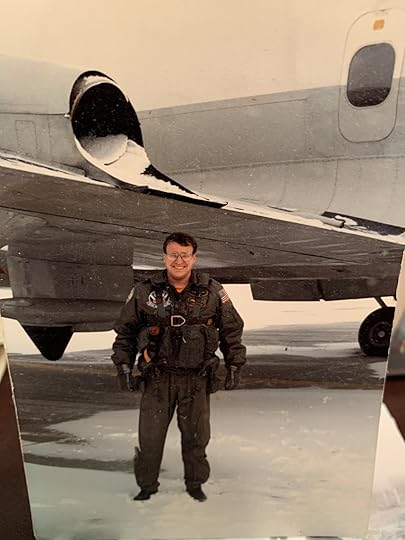 Tom Dean standing under the wing of a P-3 Orion
Tom Dean standing under the wing of a P-3 OrionTom loved his time at Ole Miss. Because he was not part of the fraternity scene, the other members of the Navy ROTC unit became his closest friends. Together they learned what they needed to know to become Navy officers, and they formed strong bonds of friendship that continue today. Over the summers, the Navy sent Tom and the other ROTC participants, referred to as “midshipmen,” to operational Navy units to acquaint them with the Navy, its mission, and its sailors. Tom’s favorite trip was his first class midshipman’s cruise, where he got underway from Subic Bay in the Philippines for seven weeks with the USS Tarawa (LHA-1) on a cruise to the western Pacific Ocean. Not only did he have a front row seat to watch the ship’s sailors and Marines in action, but he also got to visit Hong Kong, South Korea, the Philippines, and Okinawa when the ship made port calls there. As someone who had loved everything Navy since he was four, he felt like a “kid in a candy store.”
When Tom graduated from Ole Miss with a bachelor’s degree in history in July 1980, he received his commission in the Navy as an ensign. Having achieved the necessary scores on the Aviation Selection Test Battery, he was also slated to begin training at Naval Air Station Pensacola, Florida. Knowing he could not meet the vision standards set for pilots, he set his sights on becoming a Naval Flight Officer (NFO). NFOs teamed with pilots on Navy aircraft, allowing the pilots to focus on flying the plane while the NFO handled the navigation, communication, and weapons systems. Given that Aviation Indoctrination School did not begin until October, Tom spent the summer at Naval Air Station Pensacola doing whatever he could to learn about being a new Navy officer. He even volunteered as a tour guide for people visiting the USS Lexington (CV-16), a World War II-era aircraft carrier used to train new pilots on how to make carrier landings and takeoffs at sea. Getting underway with the Lexington for day trips to train pilots was particularly meaningful for Tom because his father had served on board the Lexington before Tom was born.
Tom began NFO training at VT-10, the training squadron in Pensacola designed to turn new Navy officers into NFOs. The classroom work was grueling, and Tom had never studied so hard. Because he did not want to risk being dropped from the course, he studied every waking moment, taking a break only every now and then to see a movie over the weekend. Then it was back to the library or his room at the BOQ (bachelor officers’ quarters) to pick up studying where he left off.
In addition to studying, Tom got practical experience flying in the backseat of T-2 Buckeye jet trainers. On one such flight, he was taking notes and dropped his pen. No matter how hard he strained, he could not reach it because he was strapped into his seat. His instructor pilot heard his struggle over the internal communication system and asked what was wrong. When Tom told him he had dropped his pen and couldn’t reach it, the pilot said, “Why didn’t you tell me?” Then the pilot rolled the airplane upside down so the pen fell onto the canopy where Tom could reach it. Once Tom said he had it, the pilot rolled the plane again until it was right side up. Problem solved.
As graduation from NFO school approached, Tom and the other students submitted a wish list identifying their top preferences for the type of aircraft they would like to specialize in. Tom preferred the P-3 Orion he had visited with his dad. The Navy agreed P-3s were a good fit and sent Tom to Mather Air Force Base near Sacramento, California, for long-range navigation training.
Because the P-3 Orion’s mission involved hunting adversary submarines hiding beneath the ocean’s surface and conducting reconnaissance over vast swaths of the sea, P-3 NFOs had to navigate over the ocean without regard to ground formations for points of reference. Accordingly, Tom spent seven months learning dead reckoning and celestial navigation. Once he mastered those skills, the Navy designated him an NFO in August 1981 and authorized him to wear the wings of an NFO on his uniform. His training, however, was still far from over.
Tom next reported to Deep Water Survival Training, where he had to learn how to stay alive in the ocean in the event he had to bail out over water or his plane crashed at sea. During one training event, he and his fellow students were taken off the coast of California in a boat and told to jump into the water one-by-one wearing their flight suits, boots, and life jackets. The boat crew also warned the students not to pet any seals and to avoid sharks, sending shivers up Tom’s spine. After Tom hit the cold water, he treaded water waiting for a helicopter to come and pick him up. Suddenly, he felt something brush up against the exposed skin on the back of his neck. He reached back to see what it was and discovered it was kelp, which had become hooked to his life jacket. When the helicopter finally arrived and started to extract him by rope, the helicopter’s crew noticed the kelp was coming up with him. Not wanting the kelp in the helicopter, they started to repeatedly dip Tom in the water like a teabag. When the kelp finally fell away, they brought Tom aboard the helicopter, smiling at him because of the dunking ordeal they had just subjected him to.
The week following Deep Water Survival Training, Tom reported to Survival, Evasion, Resistance, and Escape (SERE) School in Warner Springs, California. The two-week school taught Tom and other new naval aviators how to handle being captured by enemy forces. When Tom and two others were captured by trainers posing as adversary forces, Tom accidentally knocked the hat off one of the trainers. He apologized but then found himself being roughed up by his captors. As his captors focused on him, the two aviators with Tom escaped. At the debrief at the end of the school, an instructor commended Tom for his quick thinking in knocking off his captor’s hat to allow his friends to escape. Tom sheepishly accepted the accolades, knowing his actions were an accident rather than intentional quick thinking.
After completing SERE School in October 1981, Tom reported to VP-31, the P-3 training squadron at Moffet Field where new and returning P-3 pilots and NFOs received their final flight training before reporting to their operational squadrons. Harking back to his time at VT-10, Tom studied nonstop to make sure he was ready to begin flying on P-3 missions in the fleet. Given his undergraduate major was history and he had taken no computer science classes at Ole Miss, he had to work hard to learn the P-3’s electronics systems. Oceanography also proved challenging because he had to learn the science of how sound propagates through water, an essential element of hunting submarines with sonar.
Tom completed his training at VP-31 in March 1982 and finally reported to his first operational P-3 squadron, VP-9, also located at Moffett Field. He was assigned as a navigator/communicator on P-3 flights, hunting for submarines and patrolling the waters off the U.S. Pacific coast. After two months, his plane deployed for six months to Kadena Air Base in Okinawa to fly missions in the western Pacific, including off the coast of the Korean peninsula and China.
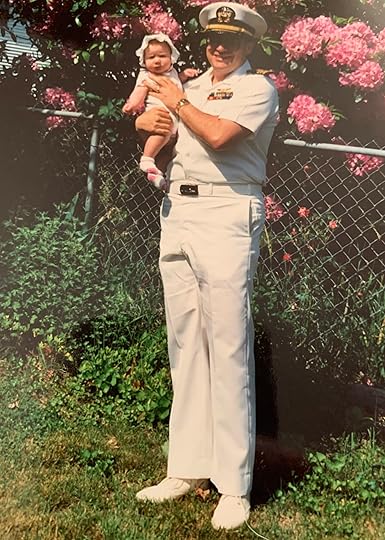 Lieutenant Commander Tom Dean holding his daughter, Lucy
Lieutenant Commander Tom Dean holding his daughter, LucyFor eight weeks of the Okinawa deployment, Tom’s plane was further dispatched to Naval Support Facility Diego Garcia in the middle of the Indian Ocean. From there the plane patrolled the waters off the coast of Somalia; landed and took off from airports in Mogadishu, Djibouti, and Oman; and flew missions all the way up the Persian Gulf to Kuwait, where Iranian anti-aircraft batteries locked onto them with their fire control radars. It even intercepted two Russian IL-38 May patrol aircraft. For three weeks of this time, the plane’s computer navigation system failed, and Tom had to determine the plane’s position and course using inertial navigation, dead reckoning, celestial navigation, and a sextant. His success validated the outstanding long-range navigation training he received at Mather Air Force Base and earned him the respect of his crew.
After Tom and the rest of his P-3’s aircrew returned to Okinawa and later to Moffett Field, they continued to hone their skills by searching for Soviet submarines in maritime patrol areas off the West Coast of the United States. To do this, the P-3’s crew dropped sonobuoys in the ocean to listen for any Soviet submarines in the area. If the sonobuoys found one, Tom’s P-3 crew would track it until they could hand it off to other U.S. units for continued monitoring. In the event of an armed conflict with the Soviet Union, Tom’s P-3 had the ability to attack and destroy any Soviet submarines it found.
As Tom gained experience, he also gained in rank and responsibility. After promoting to lieutenant (junior grade) and serving eighteen months as the navigation/communications officer on his flights, he qualified as his plane’s tactical coordinator/mission commander (TACCO). He also became the squadron’s “blue card” navigator, qualified to evaluate other navigators joining the squadron. He subsequently promoted to lieutenant in May 1985 and continued in his TACCO role for the remainder of his time with VP-9.
After one of Tom’s missions as TACCO where his P-3 located and tracked a Soviet ballistic missile submarine, the plane returned to Moffett Field at 7:00 a.m. and prepared to land. As it came in for its final approach, Tom could see people driving in bumper-to-bumper traffic along California Highway 101, unaware of the plane’s mission or how it was helping keep them safe. It made Tom feel good to be part of his squadron’s team of professionals and know their efforts were important.
In September 1985, Tom transferred back to VP-31 to become an NFO instructor. As an instructor, Tom flew on monthly long-distance navigation training missions that often included visits to Hawaii, Guam, the Philippines, and Hong Kong. He especially enjoyed his visits to the Philippines because he loved meeting the Philippine people and learning about their culture. The most important aspect of his instructor tour, though, was that he met Terry Kaiser at a bar celebrating her brother’s birthday in October 1986. Terry’s work at NASA in Imagery Technology impressed Tom, and they started dating.
When it came time to transfer from VP-31 in February 1988, Tom wanted to try something new. He asked his detailer if he could get a tour on an aircraft carrier, and his detailer obliged, sending him orders to the nuclear-powered aircraft carrier USS Enterprise (CVN-65). As the Enterprise was deployed at the time, Tom joined the ship in the North Arabian Sea. He was assigned as the OX Division head in the ship’s Combat Information Center, which managed the ship’s assets responsible for defending against adversaries.
Arriving onboard the Enterprise was like entering a new and unfamiliar world. Having spent six years on P-3 patrol aircraft, Tom knew little about life on board ships. It took him a full three months before he felt comfortable with the transition, all the time soaking up information from the many shipmates he worked with. In fact, everyone he met went out of their way to make him feel welcome and teach him what he needed to know to succeed.
One of the shipboard traditions Tom experienced was the “crossing the line” ceremony. That happened when the Enterprise crossed the equator to make a port call in Mombasa, Kenya. Because Tom had never crossed the equator on a ship before, he was considered an uninitiated “pollywog.” Accordingly, he and other pollywogs like him had to prove themselves worthy in a raucous initiation ceremony. At the end, “King Neptune” found him worthy and designated him as a trusty “shellback.” Tom still has the certificate signed by King Neptune documenting his achievement.
In April, hostilities broke out with Iran after a frigate, the USS Samuel B. Roberts (FFG-58) was severely damaged after striking an Iranian mine in international waters in the Persian Gulf. As part of the U.S. response, code named Operation Praying Mantis, planes from the USS Enterprise retaliated against Iranian navy speedboats and an Iranian frigate, causing significant damage. Tom’s role involved tracking the fuel status and refueling requirements for the dozens of USS Enterprise strike aircraft flying sorties against the Iranian targets. He also ensured Navy in-air refueling tankers, which refueled the strike aircraft throughout the day, got the aviation gas they needed from much larger Air Force KC-10 tankers circling in the area.
Tom and the USS Enterprise returned to Naval Air Station Alameda, California, on July 2, 1988. Six months later, in January 1989, he and Terry married. Then it was time for the Enterprise to begin a series of exercises to prepare for its next deployment—an around-the-world cruise. The ship began the cruise on September 17, 1989, heading west across the Pacific and making port calls in Hong Kong, the Philippines, Thailand, and Singapore.
Throughout this time and for the remainder of the cruise, Tom monitored the aviation fuel consumed by the squadrons operating from the ship. When it reached a certain level, he arranged for supply ships to come alongside the Enterprise while underway to replenish its aviation fuel supply. He also authored several critical daily reports for the ship’s operations department, helping align the department’s many functions into focused action. In the little free time he had, he went out on the carrier’s flight deck during flight operations, studying the launching and recovery of the ship’s aircraft and observing the careful choreography of the many sailors that made it happen.
After crossing the Indian Ocean, the Enterprise operated in the Arabian Sea about 100 miles south of Iran, where tensions remained high. Despite this, the ship’s executive officer decided the crew had been working hard and deserved a “steel beach” picnic, which was a giant cookout on the carrier’s flight deck. Tom could not participate in the picnic because he was standing watch as the ship’s tactical action officer (TAO), which meant he had the authority to employ the ship’s defensive weapons systems in the event of an impending attack. During Tom’s TAO watch, another U.S. ship operating in the Arabian Sea, the USS Bagley (FF-1069), reported an Iranian fire control radar had locked onto the ship. Then, radar detected two Iranian F-4 Phantom jets heading directly toward the Enterprise.
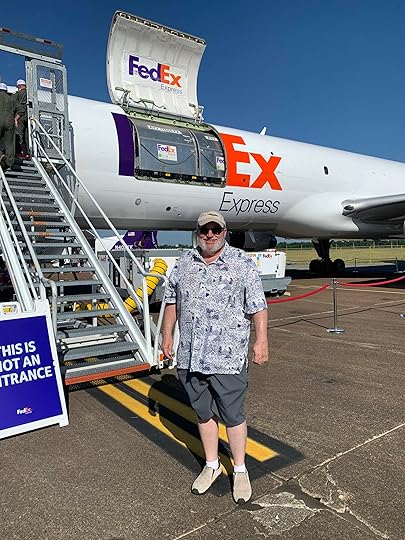 Tom Dean standing next to a FedEx cargo plane
Tom Dean standing next to a FedEx cargo planeTom knew he had no time to waste—he called the Enterprise to general quarters. Sailors on the flight deck started throwing the grills overboard to prepare the ship to launch two F-14 Tomcat fighters that were on a thirty-minute alert. The F-14s launched and intercepted the Iranian aircraft, causing them to stay clear of the Enterprise and deescalating the situation. The Enterprise’s executive officer, however, was furious because Tom’s call to general quarters brought a sudden end to the ship’s steel beach picnic.
The next day, the admiral commanding the battle group consisting of the USS Enterprise and numerous other warships directed Tom to report to the admiral’s conference room to explain what happened. After the briefing, Tom waited in the passageway outside the conference room to learn his fate. When the admiral emerged, he pulled Tom aside and said, “If I had been in your shoes, I would have done exactly the same thing.” Immediately, a huge weight lifted off Tom’s shoulders, and he could breathe again. Although the executive officer was still upset, Tom had done the right thing. He also appreciated that the admiral had supported him and taken the time to let him know. The Navy let him know he was doing a good job, too, promoting him to lieutenant commander in January 1990.
After its operations in the Arabian Sea, the Enterprise continued its way westward, crossing the Atlantic Ocean. After some final port calls in Brazil and the Caribbean, it pulled into its new homeport at the Navy Base in Norfolk, Virginia, on March 16, 1990. Tom didn’t stay with the ship long thereafter, instead heading on a temporary assignment with Patrol and Reconnaissance Wing 10 at Moffett Field, where he worked with weapons system simulators. Then in July, he and Terry moved to Newport, Rhode Island, where Tom began a year of study at the prestigious Naval War College. Not only did he earn his master of arts degree in defense and strategic studies, but he also earned a separate master’s degree in management on his own from nearby Salve Regina University. As if that wasn’t enough, Tom’s and Terry’s first daughter, Lucy, was born in February 1991.
Tom graduated from the War College in June 1991 and reported once again to VP-31 at Moffett Field in California. After completing a P-3 refresher course, he reported in December 1991 to Naval Air Station Barbers Point in Hawaii for his department head tour with VP-1. His family, which included the addition of their second daughter, Lizzie, in 1995, lived in Navy housing on Ewa Beach, just a few miles from Barbers Point. This was convenient because Tom also served as the squadron’s assistant operations officer, which required him to be available on short notice to do things like oversee the evacuation of all squadron aircraft to the mainland, which happened in September 1992 when Hurricane Iniki threatened Oahu.
Tom also continued serving as a TACCO and mission commander for VP‑1 on P-3 flights around the Pacific theater, including during a six-week deployment to Howard Air Force Base in Panama to conduct counter-drug smuggling operations with the Coast Guard. On one mission flying out of Panama, Tom’s plane directed a rescue helicopter to a badly burned civilian mariner at sea, saving the mariner’s life. After the assignment in Panama ended, Tom returned to Hawaii and remained with VP-1 until he transferred to work on the staff of Commander, Patrol Wing Pacific in 1995. There he served as the training officer responsible for weapons and cockpit simulators.
When it came time for Tom’s next set of orders in 1997, he learned he would likely have to go to another aircraft carrier. Although he loved his time onboard the USS Enterprise, he did not want to do that again, especially now that he had a young family he wanted to spend his time with. Accordingly, he took the opportunity to retire offered by the Temporary Early Retirement Authority, or TERA, put in place to help draw down U.S. military forces after the end of the Cold War. Tom officially retired from the Navy in February 1997 after seventeen years of distinguished military service, during which he amassed close to 4,000 flight hours as an NFO.
After Tom retired, he, Terry, and their two girls moved to Memphis, Tennessee. There Tom began a twenty-five-year career with FedEx as an aircraft flight dispatcher in the company’s global operations center. He loved the job because it encompassed all the skills he learned in the Navy and kept him involved in aviation. In fact, his job required him to take frequent rides on FedEx planes to maintain his aircraft flight dispatcher qualifications. Tom also maintained ties to his military roots by becoming an active member of the Veterans of Foreign Wars (VFW). To this day, what Tom values most about his service was the opportunity to work with the many outstanding Navy professionals, both at sea and in the air, keeping America safe by doing a job they all believed in.
Voices to Veterans is proud to salute Lieutenant Commander Thomas M. Dean, Jr., U.S. Navy (Retired), for his years of distinguished service to our country. From patrolling the oceans for Soviet submarines to ensuring aircraft from the USS Enterprise were able to protect U.S. forces from Iranian aggression, Tom always answered our nation’s call. We thank him for his many years of selfless service and wish him fair winds and following seas.
If you enjoyed Tom’s story, please sign up for the Voices to Veterans Spotlight monthly newsletter by clicking here. Once each month, you’ll receive a new written veteran’s story directly in your mailbox. Best of all, it’s free and you can unsubscribe at any time.
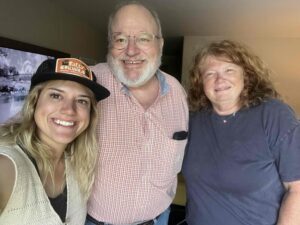 Tom and Terry Dean with their youngest daughter, Lizzie (left)
Tom and Terry Dean with their youngest daughter, Lizzie (left) The post Lieutenant Commander Thomas M. Dean, Jr., U.S. Navy (Retired) – Patrolling the Skies and the Seas to Keep Us Safe first appeared on David E. Grogan.
July 16, 2025
Specialist Jeremy Carroll, U.S. Army – From Training Troops at Fort Irwin to Collecting Intelligence in the Iraq War
America’s fighting forces are the best in the world. They earned that distinction by training day in and day out, preparing them for victory on the battlefield. Specialist Jeremy Carroll, U.S. Army, knows the importance of training better than most because he trained thousands of soldiers destined for combat in Afghanistan and Iraq. When his own turn came to deploy in 2003, he saw firsthand the benefits of realistic training and incorporated his experience into the lessons he passed on to others. As a result, his service had a positive impact on countless U.S. Army units and soldiers deployed around the world.
Jeremy was born in 1980 in West Berlin, an island of democracy surrounded by communist East Germany. His father was a U.S. Army staff sergeant stationed there during the Cold War with the Soviet Union. After West Berlin, Jeremy moved with his parents and older brother to Fort Knox, Kentucky, where Jeremy’s father was a drill sergeant. When Jeremy was almost six years old, his father left the Army and moved the family from Fort Knox to Springfield, Illinois, where they put down permanent roots.
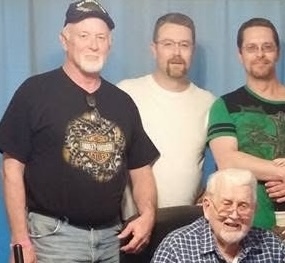 Jeremy Carroll (white shirt) surrounded by his father (left), brother (right), and late grandfather (bottom right). All are veterans.
Jeremy Carroll (white shirt) surrounded by his father (left), brother (right), and late grandfather (bottom right). All are veterans.Jeremy attended Lanphier High School where he ran cross country and wrestled until his senior year. To earn spending money during the summers, he detasseled corn on nearby farms. He also started planning his future, which, by the time he was a junior, he knew would include a stint in the Army. By joining the Army, he would be following not only in his father’s footsteps, but also in the footsteps of his older brother, his maternal and paternal grandfathers, and numerous other relatives. The Army also offered education benefits to allow him to pay for college, which he intended to enroll in after serving out his enlistment.
To follow through with his plan, Jeremy visited an Army recruiter during his senior year. He told the recruiter his older brother was a cryptologic linguist who analyzed and interpreted foreign language communications, and he wanted to do that, too. Because Jeremy spoke some Spanish, the recruiter said he could make it happen and guaranteed Jeremy a slot in the cryptologic linguist MOS (Military Occupational Specialty). However, because Jeremy was only seventeen, his parents had to give their written permission for him to enlist. They did so after he graduated from high school in June 1998.
Once Jeremy’s enlistment papers were signed enrolling him in the Army’s Delayed Entry Program, he had to wait until November to report for active duty. In the meantime, he worked at a local grocery store to earn some spending money. When his November report date finally arrived, he took a Greyhound bus to the Military Entrance Processing Station in St. Louis, Missouri, where he passed his final physical and took his oath of enlistment. Then he and the other new recruits like him boarded an Army bus on their way to basic training.
The bus arrived at Fort Leonard Wood in Missouri, or as the recruits dubbed it, “Fort Lost in the Woods in Misery,” late in the afternoon on Friday the 13th. Although the drill instructors were waiting for them, the intense basic training experience did not begin until the following Monday. Jeremy fared well during basic training because his father had been a drill instructor and told Jeremy what to expect. This cut both ways, though, after Jeremy posted a photo of his father in uniform on his wall locker. From that point on, Jeremy’s drill instructors were harder on him because they knew he knew too much about their methods and objectives.
Basic training helped Jeremy get into the best shape of his life. He arrived a wiry 155-pound runner and graduated a 180-pound muscular soldier. He also gained confidence as the drill instructors pushed him and the other recruits to their limits, making sure they would be able to handle the pressure-packed situations they were sure to encounter during their Army careers. Although Jeremy hated being pushed at the time, he accepted it as an important part of the drill instructors’ job and tried not to let it bother him.
Jeremy graduated from basic training in January 1999 and reported to follow-on training at the Defense Language Institute (DLI) Foreign Language Center (FLC) in Monterey, California. There he began a six-month course honing his Spanish language skills. At one point during the course, he needed to take care of some family matters, so he was temporarily assigned to the DLI’s casual detail, where he worked with staff managing personnel who had to be given temporary work assignments due to injury or illness. He even accompanied a chaplain on casualty calls to the family members of servicemembers who had died. The interruption of his studies meant he had to restart his six-month Spanish language course during the summer.
Despite this delay, Jeremy enjoyed the language program. He especially valued getting to meet and work with officers and enlisted members from the other military branches, each bringing unique experiences and perspectives into the classroom. His instructors, who hailed from Guatemala, Nicaragua, Colombia, and Mexico, added authenticity to the course because they were native Spanish speakers, each with their own accents and dialects to decipher. Jeremy even picked up a little Portuguese by talking to a student from Brazil and got to tour a tall ship that a foreign navy sailed into Monterey Bay.
Jeremy graduated from the DLI FLC in January 2000 and moved on to the next phase of his training at Goodfellow Air Force Base in San Angelo, Texas. There he learned to operate the equipment he needed in his role as a cryptologic linguist. After Goodfellow, he transferred to Fort Huachuca, Arizona, for training on additional equipment he would use in the field.
After successfully completing his training in November 2000, Jeremy reported to his permanent duty station at the Fort Irwin National Training Center (NTC). The NTC’s location in Southern California’s Mohave Desert made it ideal for preparing Army units to fight and win conflicts taking place in harsh desert environments. Jeremy’s role at the NTC was to serve as one of the trainers. More specifically, he was assigned to the 511th Military Intelligence Company of the Regimental Support Squadron to the 11th Armored Cavalry Regiment. The company’s mission, as was the mission of the entire 11th Armored Cavalry Regiment, was to play the role of military forces opposing the U.S. Army units rotating through the NTC at Fort Irwin for training.
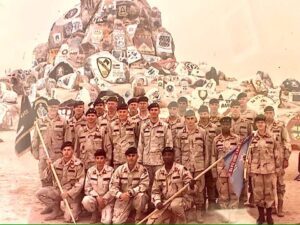 Jeremy and his platoon in front of Painted Rock at Fort Irwin
Jeremy and his platoon in front of Painted Rock at Fort IrwinAs a cryptologic linguist, Jeremy helped make the training as realistic as possible. To do so, he and the other members of his unit would do things like broadcast Spanish language radio communications and masquerade as civilians in some of the training scenarios. To make it even more real, Jeremy and his colleagues were permitted to grow their hair and dress the part, so they looked like civilians from a foreign country rather than U.S. Army soldiers.
Jeremy loved his assignment, especially since he knew he was training his fellow soldiers on how to survive in the event they found themselves in harm’s way. He found it fun, too, sometimes like a big game of laser tag. This was because Jeremy’s opposition forces and the U.S. Army forces being trained engaged each other with laser training weapons during exercises. When sensors worn by individuals or placed on vehicles lit up indicating they had been successfully targeted by a laser, the affected individuals were designated casualties and taken out of action. For Jeremy’s opposition forces, getting “killed” meant they could pull a grill out of their vehicles and cook some hamburgers and hotdogs in the desert while the exercise scenario continued. In contrast, the Army units being trained had to react to the incident just like they would on an actual battlefield by evacuating any wounded soldiers and retrieving damaged equipment.
Every July and December, the tables turned, and Jeremy’s unit became the unit being trained. This meant the members of Jeremy’s unit had to practice driving and maneuvering their vehicles loaded with intelligence collection equipment in the desert, setting up tactical operations centers, and defending their positions against other units playing opposition forces. In short, they had to make sure they could live up to the same standards they enforced on others.
Ten months into his assignment with the 511th Military Intelligence Company, Jeremy’s team was at the NTC pool conducting drown-proof training. The training required the soldiers to jump into the pool wearing their uniforms and then keep themselves afloat until they were told they could get out of the water. In the middle of the session, the first sergeant overseeing the test told them the World Trade Center had just been attacked. From that point on, life at NTC changed. The most immediate change was the Army restricted access to the base, making it at first impossible and then difficult for anyone other than a military member to enter. More importantly, the training Jeremy and the other members of the opposition forces conducted took on added significance because everyone knew the units being trained could be on their way to Afghanistan to avenge the 9/11 attacks.
In the February/March timeframe of 2003, Jeremy and eleven other members of the 511th Military Intelligence Company were selected to augment the 66th Military Intelligence Company supporting the 3rd Armored Cavalry Regiment at Fort Carson, Colorado. There he found himself reporting to a soldier he had trained at Fort Irwin, which made him feel proud that his efforts had helped her excel and advance. Jeremy and the other eleven augmentees trained with the 66th Military Intelligence Company and deployed with the unit on April 4, 2003, to take part in the war in Iraq.
The company’s initial stop on its deployment was in Kuwait, where it waited for its equipment and orders. From there it went to Ramadi in central Iraq, just sixty-eight miles west of Baghdad. Jeremy and other soldiers from the unit were then directed to operate out of Fallujah, a city located about midway between Ramadi and Baghdad. Their camp was inside the city limits in a walled compound that had previously been used as a resort for Ba’ath Party members.
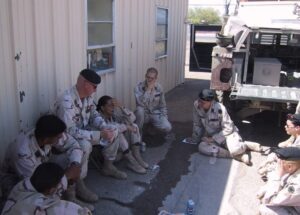 Jeremy and members of his platoon waiting for their next training mission at Fort Irwin
Jeremy and members of his platoon waiting for their next training mission at Fort IrwinJeremy’s primary duty involved collecting intelligence to support allied military operations. This included driving through the surrounding area collecting communications intelligence using mobile equipment carried on his vehicle. During these excursions, Jeremy and his teammates were frequently shot at by insurgents seeking to disrupt their activities. Jeremy also spoke with local people in the towns and villages he visited, gaining their trust and insight, and participated in interrogating detainees. After collecting the intelligence, Jeremy and his teammates prepared written reports documenting what they learned, which they then delivered in person to the headquarters element of the 66th Military Intelligence Company in Ramadi. Jeremy routinely came under fire during these trips to and from Ramadi. Although he had some close calls, he was never injured.
Despite being in constant danger during his time in Iraq, Jeremy enjoyed meeting and talking to the Iraqi people and learning about their culture. Although some of the Iraqis were hostile, he found most to be very nice and respectful, mainly interested in peacefully getting on with their lives and taking care of their families. He also enjoyed interacting with allied forces and remembers talking with members of an Australian unit passing through Fallujah. He found them just like the members of his own unit—excited about their mission and wanting to do a good job—but speaking with an accent and having different life experiences growing up. Still, the camaraderie and bonds of military service connected them. He even got the chance to practice his Spanish skills with an engineer he met who was checking out the structural integrity of a nearby dam.
Jeremy also found beauty in the otherwise desolate Iraqi landscape, especially as the sun set each night in the western sky. Driving through one town whose sole color was that of sand, he saw a man’s finely pruned rose garden with stunning red flowers adding accent to the monocolor background. Even the desert temperature provided stark contrast, with stifling 110-degree days giving way to seemingly frigid 80-degree nights.
By the beginning of June 2003, the 66th Military Intelligence Company had done all it could in support of the U.S. war effort, and it redeployed to the United States. Jeremy and the other eleven members of the 511th Military Intelligence Company then returned to their roles at Fort Irwin training Army units to prepare them for combat. However, as a result of the wars in Afghanistan and Iraq, the training changed from emphasizing maneuver warfare in the desert to dealing with insurgents in cities and towns.
Jeremy saw the change in emphasis as an opportunity to inject his recent experience in Fallujah into the training. He suggested his unit do things like portray protests in the mockups of the towns and throw things like water balloons at the soldiers being trained so they would learn how to handle tense situations simmering on the edge of violence. Unaware of Jeremy’s recent experience, his company commander was skeptical and asked Jeremy how he knew these were the kind of things soldiers would have to face when they deployed. Another soldier replied, “He just got back from Iraq, sir.” That was good enough for the company commander, and he gave Jeremy and the others who deployed with him the creative license they needed to implement their ideas.
In November 2003, Jeremy’s five-year enlistment ended. He thought about reenlisting but decided instead to move on. After receiving his honorable discharge, he returned to Springfield, Illinois, to pick up where he left off in 1998. He started by taking electronics technology courses at Lincoln Land Community College during the day and working as a night auditor at a hotel on nights and weekends. After two years at the hotel, he transitioned to security work, including at the grocery store where he had worked the summer before reporting for basic training.
After the grocery store, Jeremy found his calling working with special needs kids in his local school district. He is certain the kids saved his life, helping him overcome PTSD from his time in Iraq. He reasoned if these kids could deal with their disabilities for their entire lives, he could deal with his disability for the rest of his. He worked with the kids for thirteen years and still returns to the school to visit the kids and staff for inspiration and support. Now Jeremy works at Camp Butler National Cemetery northwest of Springfield, helping maintain that hallowed ground for veterans and their families. Jeremy has several relatives buried at the cemetery but considers all the veterans buried there to be part of his family.
Jeremy’s support of veterans goes beyond his day job. He is an active member of the Veterans of Foreign Wars (VFW) La Fore Lock Post 755, where he serves as a member of the post’s color guard and as its chaplain.
Voices to Veterans is proud to salute Specialist Jeremy Carroll, U.S. Army, for his distinguished service to our country. In addition to providing realistic training to his fellow soldiers to help them win on the battlefield, he deployed to Fallujah during the Iraq War and developed intelligence that saved American and allied lives. He continues to serve both at work and through the VFW, helping veterans and their families in Central Illinois. We thank him for all he has done and wish him fair winds and following seas.
If you enjoyed Jeremy’s story, please sign up for the Voices to Veterans Spotlight monthly newsletter by clicking here. Once each month, you’ll receive a new written veteran’s story directly in your mailbox. Best of all, it’s free and you can unsubscribe at any time.
The post Specialist Jeremy Carroll, U.S. Army – From Training Troops at Fort Irwin to Collecting Intelligence in the Iraq War first appeared on David E. Grogan.
June 18, 2025
Specialist Dale Abbott, U.S. Army – Serving in the National Guard: From Illinois to Desert Storm
Because National Guard units serve both the state and federal governments, members are often the face of the military most familiar to many Americans. When disaster strikes in a state, the governor calls upon the National Guard to respond. If our nation goes to war, the Guard’s citizen soldiers are expected to answer the call. Specialist Dale Abbott understands these state and federal roles all too well. He joined the Illinois Army National Guard and soon found himself driving a truck in Operation Desert Storm. After he returned, he helped people in flood-ravaged areas of southern Illinois. Both efforts were a far cry from his humble beginnings.
Dale was born in St. Louis in 1971 and raised in Effingham, Illinois. His biological father was never in the picture, and his biological mother could not handle the responsibility of raising a child, so both Dale and his older brother were adopted and raised by their maternal grandmother and her husband. In fact, Dale’s grandmother was the only mother he ever knew, and he called her and her husband mom and dad. Dale’s adoptive parents were also foster parents, fostering a total of forty-eight children over the years, so there were always lots of kids and their friends hanging out around the house. Since Dale’s dad worked for the railroad and travelled frequently, the bulk of the responsibility for all the kids fell to Dale’s mom, leaving the house in a state of controlled chaos twenty-four hours a day.
Dale attended public schools through the end of his sophomore year at Effingham High School, where he played football. He then transferred to Crossroads Christian Academy for his final two years, leaving football behind. To earn spending money, he delivered newspapers on a route he acquired when he was twelve. He also started working at a meat processing company when he was fifteen, helping skin and process deer and other meats during hunting season. Once he got his driver’s license, he began working for a landscaping company.
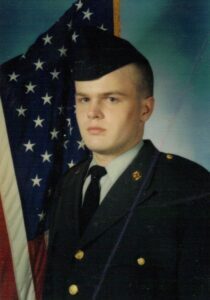 Dale Abbott at basic training
Dale Abbott at basic trainingAfter Dale graduated from high school in 1989, he continued working for the landscaping company. He had no intention of making that a long-term career, though, because he already knew exactly what he wanted to do. He had befriended an old World War I veteran who lived on his street and loved to listen to his stories. He had also seen a flag that had been presented to his great-great-great-grandfather in recognition of his service during the Spanish American War. The result was Dale had patriotic blood flowing through his veins. Accordingly, Dale trekked to a recruiter in Effingham and enlisted in the Army National Guard’s 1544th Transportation Company, headquartered in Paris, Illinois, making him the first person to enlist in the military on his mother’s side of the family since his great-great-great grandfather. He planned on serving out his enlistment, attending college, and then joining the active-duty Army after he earned his degree.
In May 1990, Dale reported to the Military Entrance Processing Station (MEPS) in St. Louis, Missouri. He passed his final physical exam, took the oath of enlistment, and headed to Fort Dix, New Jersey, for basic training. Upon arrival, he was herded into a big room where drill instructors shouted orders telling the recruits where to go. Dale did not understand the instructions and feared he would be the first to be called given that his last name was Abbott. Miraculously, they called another recruit whose last name was Abbie, and when Abbie didn’t know where to go, the drill sergeants lit into him. Dale heard his name called next. He jumped up and took a seat next to Abbie, relieved he knew where to go. His relief was short-lived because the drill sergeants still found something to yell at him about anyway.
Although basic training challenged every recruit, Dale excelled. He was in the best shape of his life and was a particularly strong runner. He needed to improve at pushups, however, and that was where another recruit, Jeff Burris, came in. Jeff helped Dale improve his pushups, and, in return, Dale coached Jeff on his running. The two became best friends and together they worked through all the typical basic training hardships. Both graduated as privates after eight weeks, and they transitioned together directly into Advanced Individual Training (AIT), also at Fort Dix. There they learned to drive all kinds of Army vehicles, including Humvees, five-ton trucks, semis, and buses.
Dale and Jeff graduated from AIT in September 1990 with the job designation of motor transport operator. As Jeff had coincidentally enlisted in the same unit as Dale, they both reported for their first monthly drill weekend with the 1544th Transport Company in October just as military units around the country started to deploy to the Middle East as part of Operation Desert Shield. The goal of the operation was to deter further aggression by Iraq after it invaded Kuwait in August and to put U.S. and allied military units in position to liberate Kuwait when the time came. Within weeks of their first drill weekend, Dale and Jeff learned their unit would also deploy and join the U.S. war effort.
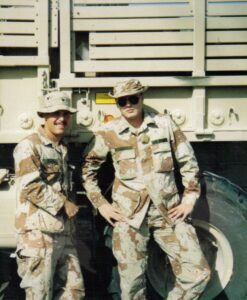 Dale Abbott (right) and Jeff Burris (left) in Saudi Arabia
Dale Abbott (right) and Jeff Burris (left) in Saudi ArabiaAs Dale and Jeff were recent AIT graduates, they had the latest operational training in the unit, making them invaluable assets as the company prepared to deploy. Within weeks, everyone in the company moved by bus to Fort Campbell, Kentucky, where they received additional training and a battery of shots. Given the fear Iraq might employ chemical or biological weapons, they also practiced using special clothing and equipment—referred to as Mission-Oriented Protective Posture (MOPP) gear—designed to protect them from those types of weapons. In addition, Dale completed combat field medic training as well as advanced courses in tactical driving and dealing with chemical and biological weapon attacks.
The 1544th Transportation Company trained at Fort Campbell for a few weeks before loading onto Air Force transport aircraft and heading to Saudi Arabia. The unit arrived on November 6, 1990, and lived in a tent city while waiting for the unit’s vehicles to arrive. Once that happened, Dale and Jeff parted company, with Jeff and his platoon driving eighteen-wheel semis and Dale and his platoon driving the M939 six-wheeled heavy-duty truck, which could haul up to five tons of cargo in its bed.
Dale immediately began hauling people, equipment, engine parts, ammunition, food, water, and other supplies across the Saudi desert to wherever the cargo needed to go. Although he sometimes overnighted at places like King Khalid Military City or an abandoned cement factory near Damman dubbed “Cement City,” he made a point to spend as much time on the road as possible. If the unit needed a driver to haul something somewhere, Dale volunteered. As a result, he spent many nights sleeping in his truck.
By mid-January 1991, sufficient U.S. and allied forces were in place to begin the combat phase of their deployment, known as Operation Desert Storm. In anticipation of casualties, Dale drove doctors and nurses from a hospital unit into the Saudi desert to support the 1st Cavalry Division. That evening, as Dale sat in his truck with a nurse listening to “In the Air Tonight” by Phil Collins, they were notified that the air war had started. Accordingly, they were issued pills to hopefully deter the effects of any nuclear, biological, or chemical (NBC) weapons the Iraqis might use in a counterattack. That Phil Collins song has been etched in Dale’s mind ever since.
Dale and the other members of his platoon drove their five-ton trucks both on and off roads, often having to navigate their way across the pitch-black Saudi desert. With no readily observable waypoints, they often got lost and had to feel their way to their destinations in the dark. More than once, they drove into concertina wire surrounding a darkened allied camp. Dale twice had to cut his vehicle free from concertina wire and assisted his fellow drivers at least twenty times doing the same. Yet concertina wire around friendly camps was the least deadly of Dale’s concerns once the Iraqis started firing Scud ballistic missiles capable of carrying high explosives and chemical weapons at the allied forces massing for attack.
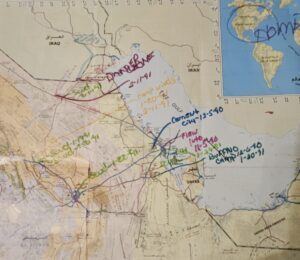 Map showing the locations in Kuwait and Saudi Arabia where Dale Abbott experienced Scud attacks
Map showing the locations in Kuwait and Saudi Arabia where Dale Abbott experienced Scud attacksDale endured six Scud attacks during his time in Saudi Arabia. The most memorable occurred after he and another soldier drove together with other trucks from Dale’s platoon to a Saudi port to pick up some cargo. During the drive to the port, the soldier saw a Bible Dale kept in the cab of his truck and asked if Dale was “one of those religious guys,” making it clear to Dale the soldier was not. A few hours later as they waited in the truck for the cargo to be loaded, sirens warned of an impending Scud attack. Dale and the other soldier got out of the truck, donned their MOPP gear, and anxiously waited to see what would happen. Moments later, a U.S. Patriot missile intercepted a Scud overhead, and shrapnel rained down on the platoon’s trucks. The soldier Dale was with quickly climbed back into the truck to avoid getting hit by the falling debris. When Dale joined him a few minutes later, he looked over at the soldier only to see him “reading the hell out of the Bible.” The other attacks Dale witnessed consisted of alarms followed by Patriot missiles intercepting the Scuds before they could do any harm. After surviving each one, Dale carved a notch in his truck’s steering wheel.
Once ground combat operations against Iraqi forces in Kuwait commenced on February 24, 1990, Dale’s transportation missions included hauling cargo across the desert to 1st Cavalry Division units in Kuwait. As a result, he was exposed to depleted uranium ammunition rounds and to toxic fumes from oil wells set on fire by retreating Iraqi units. Other toxins flowed from burn pits used to destroy waste, trash, and unexploded ordnance. At times, the smoke was so dense it looked like nighttime in the desert even though it was the middle of the day. Although this caused health problems for Dale later in his life, at the time, no one from 1544th Transportation Company sustained any combat-related injuries. One unit member—a soldier who had survived two tours of duty in Vietnam—did have to be evacuated after being bitten by a poisonous snake. He survived, although the bite made him very sick.
Snakes and Iraqi attacks weren’t the only dangers Dale and his fellow drivers had to contend with. In fact, one of the biggest dangers came from Saudi drivers, who were notoriously risky on the road. Dale witnessed this firsthand as his convoy drove down a two-lane highway. A Saudi driver tried to pass the convoy by veering into the oncoming traffic lane despite a large truck approaching him at high speed. The Saudi driver tried at the last moment to swerve back into the right lane, sideswiping one of the convoy’s five-ton trucks before being crushed by the truck in the oncoming lane. The Saudi driver—who was completely at fault in the accident—died on the scene. This was but one of the many accidents Dale saw involving local drivers. As proof in point, one of the roads leading into Kuwait was known as Dodge Road because Army drivers had to dodge all the abandoned wrecks involving Saudi and Kuwaiti civilian vehicles.
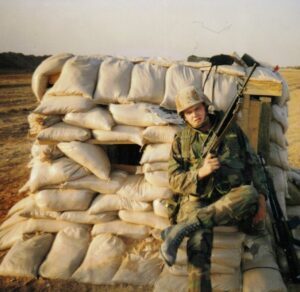 Dale Abbott at training
Dale Abbott at trainingDesert Storm combat operations ended on February 28, 1991, and Dale and the rest of the 1544th Transportation Company returned to Paris, Illinois, in the months that followed, but not before Dale promoted to private first class. He then began drilling one weekend each month and two weeks out of each year as he originally envisioned at the time of his enlistment. What he did not envision was meeting the love of his life, Tammy Seeley, in a gas station near Effingham. They were married in June 1992 at just about the same time Dale started to become ill from the toxins he was exposed to during Operation Desert Storm.
Dale continued serving with the Illinois National Guard throughout 1992 and into 1993. In addition to promoting to specialist, he either trained or drove trucks during those drill periods, depending upon the unit’s needs. In the summer of 1993, the governor of Illinois called upon Dale and the rest of the 1544th Transportation Company to help fill sandbags in the southern part of the state to deal with extensive flooding. However, by the end of 1993, Dale’s Desert Storm illnesses, together with a freak accident he suffered while remodeling his house, signaled the end of his Army National Guard career. He received his honorable discharge at the end of his enlistment in August 1994 and focused on his full-time civilian career.
After an initial stint doing computer imaging for a landscaping company in Effingham, Dale moved with Tammy to Springfield, Illinois. There Dale began working as a general manager at a full-service car wash, a position he held for almost thirty years. He finally retired in 2023 and now devotes his free time to assisting veterans in any capacity he can. As part of that effort, he and his friend, Jeff Burris, are starting a podcast called Veteran Chow Line to facilitate veterans talking with each other about veterans’ issues.
Voices to Veterans is proud to salute Specialist Dale Abbott for his service in the Illinois Army National Guard. Not only did he serve the people of the great state of Illinois, but he also deployed as part of the victorious U.S.-led Desert Storm coalition, helping drive the invading Iraqi military out of Kuwait. Despite the illnesses he suffers due to his exposure to toxic substances during Desert Storm, he continues to devote his full energy to helping veterans today. For all he has done, and for all he continues to do, we wish him fair winds and following seas.
If you enjoyed Dale’s story, please sign up for the Voices to Veterans Spotlight monthly newsletter by clicking here. Once each month, you’ll receive a new written veteran’s story directly in your mailbox. Best of all, it’s free and you can unsubscribe at any time.
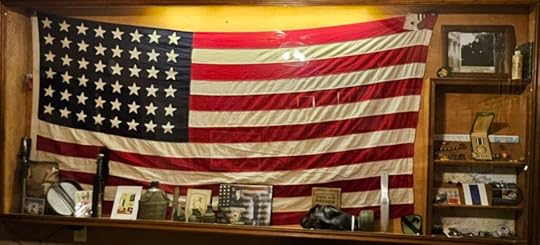 Dale Abbott’s display case containing memorabilia from his participation in Operation Desert Storm. The photo in the upper right corner is Dale’s great-great-great grandfather, who fought in the Spanish-American War.
Dale Abbott’s display case containing memorabilia from his participation in Operation Desert Storm. The photo in the upper right corner is Dale’s great-great-great grandfather, who fought in the Spanish-American War. The post Specialist Dale Abbott, U.S. Army – Serving in the National Guard: From Illinois to Desert Storm first appeared on David E. Grogan.
May 7, 2025
Chief Michelle Ramlow, U.S. Navy (Retired) – Service When It Counts: Desert Storm, the Pentagon on 9/11, and Kuwait
The terrorist attacks on the United States on September 11, 2001, mark a defining moment in U.S. history. Many Americans remember exactly where they were and what they were doing when they learned of the attacks. Yeoman Chief Petty Officer Michelle Ramlow, U.S. Navy (Retired), has had many such defining moments. Not only did she survive the September 11 attack on the Pentagon, but she also deployed on a ship as part of Operation Desert Storm and served in Kuwait during the Iraq War. Throughout these events, and at all times in between, Michelle served with distinction and proudly carried on her family’s tradition of military service.
Michelle was born and raised in Lincoln, Illinois, a small town located approximately 170 miles southwest of Chicago. Her mother was a hairdresser and her father a factory worker. More important to Michelle, her father was a veteran, having served as a Communications Yeoman in the Navy during the Vietnam War. Her paternal grandfather was also a veteran, as were several of his brothers, all having served in World War II.
Before Michelle could consider the military, she had to graduate from high school. She attended New Holland-Middletown High School with eighty-three other students in the top four grades. In addition to videotaping the school’s basketball games and running the scoreboard for the volleyball team, Michelle worked as a waitress at Pizza Hut to keep spending money in her pocket.
Michelle and the other thirteen members of her senior class graduated in the spring of 1988. Because she had a boyfriend at the time and wanted to stay local, Michelle continued to work at Pizza Hut after graduation, supplementing her income with earnings from a job at a local clothing store. When she and her boyfriend broke up, she began to think seriously about joining the military. Although she thought it important to continue her family’s tradition of military service, that was not the only factor influencing her decision. When she was in the eighth grade, she saw a photo of a woman running an Army obstacle course. Seeing the woman taking on the challenging course convinced Michelle she could do it, too, and now the memory of that photo inspired her once again.
Armed with her family heritage and inspired by an anonymous woman in a photo, Michelle set out to join the military. Because of the photo, her intention was to join the Army, but her father cautioned her not to act rashly. He recommended she research all four services to see which one’s benefits were most in line with her long-term goals. With her father’s advice in mind, Michelle visited the recruiting office in Lincoln in late 1988.
Michelle quickly whittled down her choices. The Air Force did not interest her, so she started with the Marines. As the recruiter did not appear overly receptive, she next looked to the Army and the Navy. Although the Army had the obstacle course photo on its side, Michelle’s father’s service and the Navy’s college benefits sealed the deal. In February 1989, Michelle signed the initial paperwork to enlist in the Navy.
In March, Michelle reported to the Military Entrance Processing Station (MEPS) in St. Louis. She intended to enlist in the Navy Reserve, but some very persuasive petty officers convinced her she should elect active duty instead. She agreed, and, after passing her final physical and taking the oath of enlistment, she became an official Navy recruit. She did not, however, immediately report to boot camp. Instead, she returned home until later in the month when she flew to Naval Training Center (NTC) Orlando for boot camp.
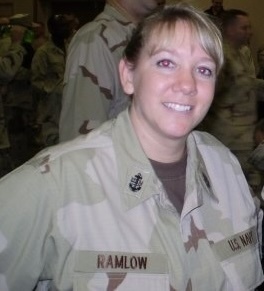 Chief Petty Officer Michelle Ramlow in Kuwait
Chief Petty Officer Michelle Ramlow in KuwaitMichelle arrived at NTC Orlando in the evening together with a number of other recruits. The first thing they had to do was take a urinalysis test to detect any illegal drug use. Afterwards, they were taken to their barracks and told to get some sleep. Michelle felt naïve and had no idea what to expect. She found out quickly at 5:00 a.m., when the recruit division commander started banging on a trash can lid and yelling at everyone to get out of bed.
Despite her naiveté, Michelle acclimated to boot camp quickly. Given that she weighed only ninety-six pounds when she arrived, she especially enjoyed the meals. Growing up in such a small town, she and her family rarely ate at restaurants. When they did, they never got to eat desserts because doing so was a luxury the family could not afford. At boot camp, Michelle could eat anything she wanted in the allotted fifteen-minute chow time. Accordingly, she started every meal with dessert.
The hardest part about boot camp for Michelle, as it was for many of the recruits, was being away from home for the first time. The separation from her family put an emotional strain on her, but she found solace in attending church services on Sunday mornings. Her time at church proved therapeutic, giving her the strength she needed to endure another week. Over time, she became stronger and more confident in her abilities, and she began to feel comfortable in her new role. She especially enjoyed meeting people from around the country and from all different walks of life, learning about their experiences and what brought them into the Navy.
Bootcamp lasted eight weeks. After graduation in May 1989, Michelle reported to Seaman Apprentice School, also at NTC Orlando, to learn the basic responsibilities of a sailor headed for duty in the fleet. At the school, she and other seaman recruits (E-1s) fresh from boot camp trained on the USS Blue Jacket, a landlocked and down-sized replica of a World War II era destroyer. The Blue Jacket provided a realistic platform on which to learn and practice the courtesies, routines, and duties Michelle needed to know for her first shipboard assignment.
Just as at boot camp, Michelle and the other female sailors trained alongside their male counterparts, although their living quarters were on separate floors within the barracks. Together they learned the art of marlinspike seamanship, which literally involved learning the ropes. As they all knew they would be assigned to the Deck Department on their first ship, marlinspike seamanship taught them how to tie knots, splice and store ropes, and use the marlinspike rope-working tool. Michelle also learned a valuable practical lesson at the school. When she found her chief petty officer’s nasty-looking coffee cup, she tried to be helpful and washed it for him. When he saw the squeaky-clean cup, he made it clear to her in no uncertain terms that coffee cups were never to be washed because the nastier they were, the better the coffee tasted. Put another way, “old salts” don’t use clean cups.
Michelle completed Seaman Apprentice School and reported to her first ship, the USS Cape Cod (AD-43), in June 1989. The ship was a destroyer tender—a floating repair shop for the Navy’s surface combatants—commissioned in 1982 and homeported in San Diego, California. She felt overwhelmed as she walked toward the 643-foot-long ship at Naval Station San Diego’s busy 32nd Street Piers, certain she would get lost and die and no one would ever find her. She arrived a day early on a Saturday and was assigned a bed (“rack” in Navy parlance) in a berthing space approximately fifty female sailors called home. However, because it was a weekend, many of the sailors were off the ship. With nothing else to do, Michelle stowed her gear, got something to eat at the McDonald’s at the end of the pier, and read books in her rack all weekend.
On Monday morning, Michelle reported to the ship’s Deck Department to begin work. She was assigned to the 1st Division, where she learned the art of deck preservation. This meant long hours of scraping old paint from the ship’s hull and superstructure and then coating the clean surfaces with a fresh coat of haze-gray paint. She also performed daily preventive maintenance to ensure the deck-related equipment was always in good working order. To determine what maintenance she needed to do, she consulted the ship’s periodic maintenance schedules and then performed the tasks identified for that day. She also conducted spot checks on equipment to make sure it functioned properly.
Three months into Michelle’s assignment, the Cape Cod deployed for six months to the western Pacific (WestPac). As a new sailor and one of the most junior members of the crew, this meant Michelle had to spend time “mess cranking”—working in the ship’s main galley to help feed the ship’s enlisted crew. Her duties included handing out trays to those waiting in line for chow, ensuring the condiment bottles remained full, and working in the scullery disposing of uneaten food and washing the serving trays, plates, cups, and silverware. Eventually, she gained enough experience to work in the chief petty officer’s mess, which was where the ship’s senior enlisted leaders ate. Not only was this a step up from the main galley, but it also helped expose Michelle to senior enlisted leaders from outside the Deck Department. When she wasn’t mess cranking, Michelle was back working in the 1st Division, conducting preventive maintenance and making sure the division’s spaces remained clean and operational.
Although the WestPac deployment meant a lot of hard work and long periods at sea, it also meant port calls in exotic places like Hawaii, Hong Kong, Singapore, Thailand, and Malaysia. In addition to drinking and blowing off steam ashore, Michelle enjoyed taking the tours in each port arranged by the ship’s morale, welfare, and recreation (MWR) team. Since Michelle had not strayed far from Lincoln, Illinois, growing up, these port calls opened her eyes to new cultures and life experiences.
Not long after Michelle and the Cape Cod returned to San Diego in April 1990, they got underway to participate in Operation Desert Storm. Michelle was again assigned mess cranking duties, this time working in the officers’ wardroom. The wardroom atmosphere differed from the other two places she’d worked in that it was set up like a fancy restaurant with nice linens and place settings. Michelle had to set the tables, fold the napkins, serve the food, and remove the finished plates. Although her job was much like that of a glorified waitress, she enjoyed the assignment because, as in the chief’s mess, working in the wardroom gave her exposure to the officers leading all the ship’s departments and divisions. Not only did the officers see what a hard worker she was, but she also learned a lot by listening to their conversations and observing their interactions.
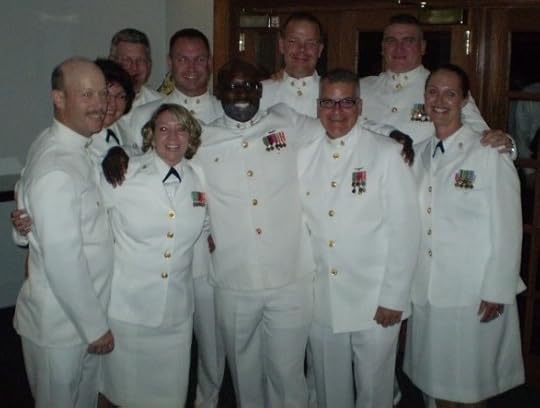 Chief Michelle Ramlow (front row, second from left) with her fellow chiefs at a formal dining in
Chief Michelle Ramlow (front row, second from left) with her fellow chiefs at a formal dining inFor part of the Desert Storm deployment, Cape Cod operated in the Persian Gulf in the vicinity of Bahrain and Abu Dhabi. This allowed the ship to provide repair and logistical support to other Navy ships participating in the war. The weather was oppressively hot, so the captain permitted the ship’s sailors to turn their dungarees into shorts by cutting the legs off no more than six inches above the knees. Michelle and other sailors working outside took advantage of the opportunity, carrying out their duties wearing white t-shirts, blue dungaree cut-off shorts, and steel-toed black boots. Although Michelle knew it would never catch on as a fashion trend, the uniform modifications made the extreme heat more bearable.
Cape Cod’s proximity to Bahrain also allowed the ship to make a port call at Administrative Support Unit (ASU) Bahrain. Michelle and the other sailors from the ship were permitted to go ashore to the ten-acre U.S. facility, grab a few beers and a shawarma, lounge around a pool, listen to music, and dance. Although the visit was much too short, it provided a welcome respite and recharged the crew for its duties at sea in support of the ongoing war effort.
The Desert Storm deployment gave Michelle the opportunity to “strike for a rating,” which is Navy terminology for studying and qualifying for a new career field. Michelle took Navy correspondence courses to explore several job categories like Master-at-Arms and Legalman, but the Yeoman (YN) rating naturally drew her because her father had been a Communications Yeoman. To gain experience, she started working in the Deck Department’s administrative office doing paperwork and practicing her typing.
The shift from working as a roll-up-the-sleeves sailor to processing paperwork in the Deck Department’s administrative office had its pluses and minuses. On the plus side, Michelle intended to return to Illinois at the end of her enlistment and believed the administrative experience she would gain as a YN would help her find a civilian job. On the minus side, she missed the work she did as part of the 1st Division and the sense of accomplishment she felt seeing projects through from start to finish. In addition, the lieutenant in the Deck Department worked her hard, even after the deployment when the ship was in port. The lieutenant never hesitated to call her in to work on her day off or pull her out of a movie to get something done.
On one occasion, the lieutenant directed Michelle to tell a first class petty officer that the lieutenant wanted to see him. Michelle did as instructed, and the petty officer told Michelle to tell the lieutenant he would be right there. When Michelle reported back to the lieutenant, she told Michelle that was not good enough. She instructed Michelle, who was a seaman (E-3) at the time, to tell the first class petty officer (E-6) he needed to report immediately. She said Michelle was acting with her authority and needed to convey confidence when carrying out her directives. Although the experience was very difficult for Michelle because the first class petty officer significantly outranked her, it helped make her a better leader. She learned to carry herself with greater confidence and soon people began listening to what she had to say.
After Desert Storm, USS Cape Cod turned toward home. On the way, the ship detoured to assist with humanitarian efforts in the wake of Mount Pinatubo’s cataclysmic eruption in the Philippines. Once the ship and crew had done all they could, they finally returned to San Diego. There, Michelle took the YN exam and passed. When promotion time came, she was officially designated a YN. Just as important, she removed the three seaman stripes from her uniform and replaced them with the crow and chevron insignia of a petty officer third class (E-4). In recognition of her new rating, she also moved to the ship’s admin office, where she perfected her typing skills, learned the office tickler system, typed correspondence, and answered congressional inquiries.
Once Michelle mastered basic YN skills, she transferred again, this time to the Supply Department’s admin office, where the job required more independent action. The supply officer made it clear to Michelle during her in-call that she could be bribed with chocolate. Michelle took full advantage of that knowledge. Whenever she needed something special, she gave the supply officer M&Ms and usually got what she wanted. She also enjoyed working with the officers and chiefs leading the department and learned a lot about its operations. In particular, she mastered preparing the eight o’clock reports, which the department used to make others aware of any ongoing issues. Michelle also helped prepare and process what seemed like a never-ending stream of evaluations for every member of the department and worked on anything else required.
In January 1993, Michelle did one more six-month deployment to the Persian Gulf with the Cape Cod. This deployment was the most challenging for the crew because a number of shipmates were lost under tragic circumstances. Two sailors died by suicide: one two days before the ship left San Diego and the other after the ship got underway. Two more attempted suicide but survived. Then a first class petty officer died from a heart attack after exercising ashore when the ship was in Bahrain. Compounding the toll, another ship sent Cape Cod the body of a sailor who had died. Cape Cod had to store the sailor’s remains until the they could be transferred to the United States. The deaths put a pall over the cruise, and everyone was glad when the ship returned to San Diego in June.
The months immediately after the deployment were decision time for Michelle. The collapse of the Soviet Union in 1991 and the resulting peace dividend years meant the Navy needed to “right size,” with fewer ships and fewer people. Michelle’s position was especially precarious because the YN rating was overmanned, so she was not permitted to reenlist. She put in a waiver to allow her to remain on active duty providing full-time support to the reserves, but the detailer would not work with her on where she might be assigned. Frustrated, Michelle decided to get out of the Navy and return to civilian life. She received her honorable discharge in August 1993.
Once out of the Navy, Michelle stayed in San Diego and began working for a networking company. Eventually, she affiliated with a Navy Reserve squadron, the VR-57 “Conquistadors,” which flew the Navy’s version of the DC-9 civilian airliner. She drilled with the squadron one weekend each month and two weeks during the year performing typical YN administrative functions. However, she was sexually harassed at the squadron, as she had been on the Cape Cod, so she left the squadron and returned to Illinois where she worked for a temporary agency.
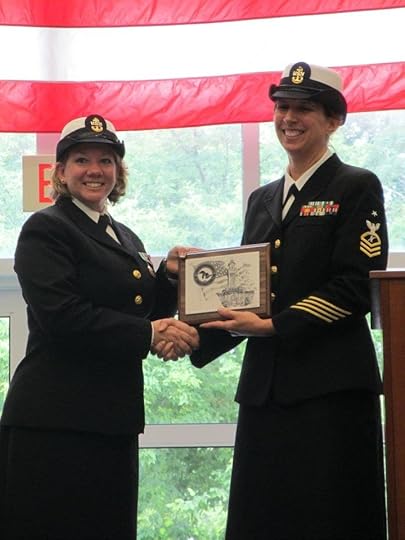 Chief Michelle Ramlow (left) with Senior Chief Legalman Julie Tessmer at Michelle’s retirement ceremony
Chief Michelle Ramlow (left) with Senior Chief Legalman Julie Tessmer at Michelle’s retirement ceremonyBy 1996, Michelle missed the camaraderie she had in the Navy and enlisted in the Navy Reserve as a third class petty officer (E-4). She did her weekend and annual drills at the Navy Reserve Center in Decatur, Illinois, until an opportunity arose for her to work with the Navy Seabees at Naval Mobile Construction Battalion (NMCB) 26 Detachment 1326, which also drilled in Decatur. When others recommended she not make the switch because it would be difficult, it motivated her that much more. She stayed with the Seabees, drilling both in Decatur and at NMCB 26 headquarters in Selfridge, Michigan, where she served as the battalion commanding officer’s YN. She promoted to petty officer second class (E-5) while there.
In June 2000, Michelle took the first of a series of active duty for special work (ADSW) assignments, meaning although she remained a reservist, she came on active duty for a specified time to assist a command that needed her expertise. Her first stint was with the Recruit Training Command at Naval Station Great Lakes, where she worked from June through October as the reserve liaison YN. In that role, she helped reservists reporting for training get to their assignments and processed awards, evaluations, and transfer packages. At the conclusion of her orders, she returned to drilling with NMCB 26 Detachment 1326 in Decatur.
In June 2001, another ADSW opportunity arose, this time on the fifth floor of the A-Ring of the Pentagon. Michelle reported on June 4 and began working as the flag writer for the deputy of the Expeditionary Warfare Division of the Office of the Chief of Naval Operations, referred to as OPNAV N75. It was a plum assignment because Michelle worked directly for a one-star admiral, handling his correspondence and providing him with whatever administrative support he required.
All went well until the admiral and most of the N75 staff went to a conference in September, leaving Michelle and three others behind. On September 11, they heard an airplane had flown into one of the towers at the World Trade Center in New York and turned on the television just in time to see another plane crash into the second tower. One of the others left behind, a corporal, said, “This is not the building I want to be in right now.” Before Michelle could respond, they felt an impact. Thinking it might have been a bomb exploding somewhere, they evacuated their spaces and headed for the outdoor courtyard at the center of the Pentagon known as “ground zero.”
Once in the courtyard crowded with people leaving the building, Michelle saw smoke billowing from the direction of her office. The officer in charge of the N75 office while the rest of the staff was in San Diego told Michelle and the corporal to drive together to the Marine Corps base at Quantico, where they could call N75 leadership in San Diego and tell them they were all okay. Rattled but now with a mission to help them stay focused, Michelle and the corporal did as instructed and made the call.
Michelle and the other members of the N75 staff were extremely lucky on that fateful day. Although they worked in the Pentagon’s Navy wing—the wing that took the direct hit by the terrorist-directed plane, they were all in their office on the Pentagon’s innermost ring at the time of impact. Moreover, the Navy wing had just been renovated, hardening it to better withstand attack. When the plane struck the E-Ring—the outermost of the Pentagon’s five rings of offices—it penetrated only to the C-Ring, leaving Michelle and the others in their A-Ring office unharmed. While their office did sustain water and smoke damage, they all survived.
After the attack, OPNAV N75 moved its offices to nearby Crystal City. Michelle continued working as the admiral’s flag writer and promoted to petty officer first class (E-6) in September 2002. After a short temporary assignment with NMCB 23 in Gulfport, Mississippi, in October, Michelle detached from OPNAV N75 in December and began working as an administrative YN for OPNAV’s Surface Warfare Division, known as N76. She continued there through September 2003, when she finally returned to Illinois to resume her drilling reservist status.
Michelle drilled with several reserve commands, providing administrative support consistent with her significant experience as a YN. These commands included Naval Reserve Naval Station Pearl Harbor drilling in Peoria (2003-2004); Recruit Training Command Great Lakes Detachment 1367 drilling in Peoria (2004-2007), where Michelle promoted to chief petty officer (E-7) in 2006; and Naval Reserve FCC Joint Task Force (JTF) Detachment 400 drilling at Naval Station Great Lakes (2006-2008). At the last command, not only did Michelle provide YN administrative support, but she also served as the senior enlisted advisor (SEA) to the commanding officer, sharing her insight and advice regarding the command’s enlisted sailors.
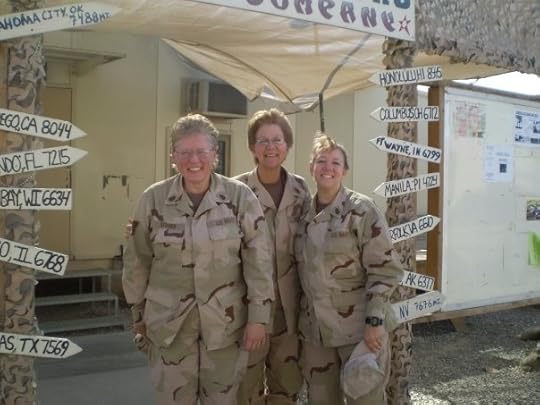 Chief Michelle Ramlow (right) with two shipmates at Camp Arifjan in Kuwait
Chief Michelle Ramlow (right) with two shipmates at Camp Arifjan in KuwaitIn September 2008, Michelle deployed to Camp Arifjan, Kuwait, as part of Navy Expeditionary Logistics Support Group (NAVELSG) Forward INDIA, replacing NAVELSG Forward HOTEL, which rotated back to the United States. Once the unit settled in, Michelle worked in the admin office as the leading chief petty officer (LCPO) and served as the sexual assault victim advocate. This deployment proved very difficult because the commander and his deputy created a toxic work environment. In particular, they discounted the significant civilian and military experience many of the reservists brought to the unit’s mission. After the deployment, they were held accountable for actions identified in numerous inspector general complaints filed against them.
Michelle arrived back in Illinois on July 18, 2009. She resumed her drilling reservist status with Naval Reserve FCC JTF Detachment 400 until September 2009. She then transferred to Naval Reserve Navy Personnel Command Detachment Great Lakes for a few months in 2010 until she returned to NMCB 27 in October. She served as the admin chief and LCPO there until she retired from the Navy Reserve in July 2012.
Although Michelle’s retirement signified the end of her Navy career, it did not end her service. In her civilian capacity, she worked as a human resources assistant for the Army ROTC unit at Illinois State University from 2007-2017. After a short hiatus working for a nonprofit, she returned to the military working for the Illinois National Guard at Camp Lincoln in Springfield, Illinois, where she currently works.
Beyond her employment, Michelle continues to support those who serve or have served in the military. She became very active in Veterans of Foreign Wars (VFW) Post 1756 in Lincoln, Illinois, serving for many years as its first female commander. She then went on to become the first female commander for VFW District 10 in the state of Illinois. She remains an active member of her Lincoln VFW Post.
Voices to Veterans is proud to salute Yeoman Chief Petty Officer Michelle Ramlow, U.S. Navy (Retired), for her decades of dedicated service. From working onboard USS Cape Cod during Operation Desert Storm, to deploying to Kuwait in the Iraq War, to surviving the September 11 attack on the Pentagon, she has always answered our country’s call. She exemplifies what it means to be a reservist, bringing capability and experience to every mission assigned. For all she has done, and for her continued service to our military and veterans, we wish her fair winds and following seas.
If you enjoyed Michelle’s story, please sign up for the Voices to Veterans Spotlight monthly newsletter by clicking here. Once each month, you’ll receive a new written veteran’s story directly in your mailbox. Best of all, it’s free and you can unsubscribe at any time.
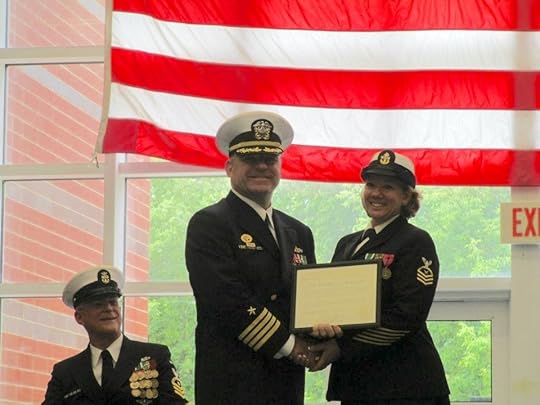 Commander Eric Johnson (left) making a presentation to Chief Michelle Ramlow (right) at her retirement ceremony
Commander Eric Johnson (left) making a presentation to Chief Michelle Ramlow (right) at her retirement ceremony The post Chief Michelle Ramlow, U.S. Navy (Retired) – Service When It Counts: Desert Storm, the Pentagon on 9/11, and Kuwait first appeared on David E. Grogan.
April 17, 2025
Technical Sergeant Kenneth Ash, U.S. Air Force (Retired) – Twenty Years of Keeping B-52s Flying
Some people come to critical decision points in their lives and wait for the Fates to make the decisions for them. Others, like Technical Sergeant Kenneth Ash, U.S. Air Force (Retired), make the hard choices themselves and chart their own paths, unwilling to leave their futures to chance. Ken joined the Air Force in 1967 rather than waiting to be drafted, beginning a journey of service that lasted twenty years. Although he had no way of knowing where his journey would ultimately take him, he knew with certainty his choice was the right one for him at the time.
Ken was born in 1947 in Otsego, Michigan, a small town located in the southwest corner of the state. His father was an auto mechanic, and his stepmother was a longtime schoolteacher. Together they raised Ken and his two brothers and two sisters. Ken attended Otsego High School, where he played basketball for his first three years and trombone in the band for all four. During his senior year, he also worked at an auto parts store with his father. He graduated in the spring of 1967, near the height of the Vietnam War.
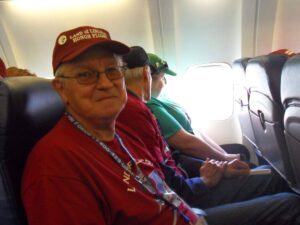 Ken Ash participating in an Honor Flight for veterans to Washington D.C.
Ken Ash participating in an Honor Flight for veterans to Washington D.C.Realizing they would soon receive their draft notices, Ken and a close friend decided to take matters into their own hands and visit an Air Force recruiter in Kalamazoo. They enlisted and were instructed to report to the Armed Forces Examining and Entrance Station (AFEES) in Indianapolis, Indiana, for their final physical exam and to take their oath of enlistment. They did as instructed; however, while Ken’s friend headed off to basic training in San Antonio, Ken did not immediately come on active duty because AFEES Indianapolis had already filled its basic training quota for the month. Accordingly, Ken went home and returned to the AFEES on July 27, 1967, to officially start his Air Force career.
Ken flew from Indianapolis to San Antonio, Texas, where he and other new recruits boarded a bus to Lackland Air Force Base (AFB) for basic training. When they arrived, they were greeted by lots of “screaming and hollering” and ushered into a big room where they met their drill instructors. Next came their barracks, new uniforms, and haircuts. Ken’s barber left him completely bald, which turned out to be okay because everyone else in his training flight—the group of trainees he was part of—was too. Soon, they all settled into their routine of getting up at 5:00 a.m., marching around the base, conducting training events like learning to fire a rifle, and eating as much as they could at the dining hall in the few minutes they were allotted at each meal.
Although basic training reminded Ken of Boy Scout camp, there were significant differences. Most obvious was the oppressive Texas summer heat. Sometimes it was just too hot to train outdoors. To determine if a particularly hot day met that threshold, Ken’s drill instructor put his bare arm on the concrete pavement. If the concrete burned his arm, he called off the affected training event. Also unlike Boy Scout Camp, basic training had drill instructors who were experts at identifying and holding recruits accountable for real or imagined infractions. Ken learned this firsthand when he had to stand with his nose against a wall until the drill instructor determined he had paid sufficiently for whatever it was the drill instructor thought he had done.
Ken graduated from basic training as an airman basic (E-1) in September 1967 and reported to Chanute AFB in east-central Illinois for hydraulics school. There he learned to repair and maintain the many hydraulic and pneumatic systems found in every type of Air Force aircraft. He completed the training in time to make it home for the holidays at the end of December. Then, in February 1968, he headed west to Fairchild AFB in Spokane, Washington, for his first operational assignment.
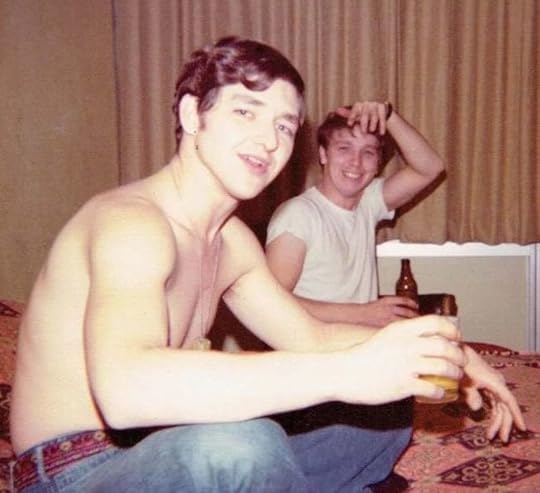 Ken Ash (left) relaxing with and Air Force friend during his six-month deployment to Guam
Ken Ash (left) relaxing with and Air Force friend during his six-month deployment to GuamOnce Ken arrived at Fairchild, he reported to the 92nd Field Maintenance Squadron, which provided maintenance support to the 92nd Bombardment Wing’s B-52 strategic bombers. Ken’s squadron assigned him to the hydraulics shop so he could put his recent training to good use. The squadron also told him not to unpack because they were getting ready to deploy to Andersen AFB in Guam, together with all the B-52s and their crews from the 92nd Bombardment Wing. Ken and the B-52s arrived in Guam in March, and soon the big jets were flying thirty combat missions a day bombing enemy targets in Vietnam. Ken understood the magnitude of the effort as he watched the B-52s take off fully loaded with tons of bombs and return many hours later with no weapons onboard.
Ken, now an airman (E-2), worked twelve-hour shifts on Guam six days a week. He worked hard in the tropical heat taking care of the B-52s’ hydraulic systems, making sure the planes were ready to fly their next mission. At the end of each shift, he usually ate at the dining hall and then got as much sleep as he could to be ready for the next day. On his one day off each week, he sometimes took the opportunity to visit Tarague Beach, which offered immaculate white sand and the warm Pacific Ocean. The base also had an outdoor movie theater at the end of one of the runways. Ken enjoyed the movies there unless they coincided with bombers taking off, which made the movies impossible to hear.
In September 1968, Ken and the rest of the 92nd Field Maintenance Squadron returned to Fairchild AFB along with the B-52s from the 92nd Bombardment Wing. Ken remained with his squadron until December, when he was able to take leave before reporting to his next assignment at the 4258th Field Maintenance Squadron at U-Tapao Air Base in Thailand.
Ken arrived at U-Tapao in February 1969 and began working in the squadron’s hydraulics shop. As with his previous assignment, he worked on the hydraulics systems for B-52s flying bombing missions over Vietnam. Also as before, he worked twelve-hour shifts, six days each week, although once a month he enjoyed a two-day break. He also promoted to airman first class (E-3) soon after arriving.
One of Ken’s responsibilities included manning the “launch trucks,” which were vehicles staffed with maintenance personnel ready in case a B-52 scheduled for a mission developed a problem. When that happened, Ken and the other technicians descended on the airplane to diagnose and, if possible, fix the problem so the airplane could fly. For example, on one occasion, a pilot complained his B-52 started shuddering as the plane rolled down the runway to take off. Concerned it could be something major, the pilot taxied the B-52 back to the runway apron to let Ken and the others investigate the problem. At first, Ken and his teammates tried running alongside the plane once it started to move to see if they could identify the issue. That didn’t work because the pilot could not replicate the problem at such slow speeds. Accordingly, the pilot convinced Ken to climb up inside the main landing gear wheel well to see if he could detect the cause of the vibration while the pilot got the plane going faster down the runway. Ken agreed, but only after the pilot promised him the plane would not take off. This time, when the pilot got the B-52 speeding down the runway, Ken felt the shudder, too, and recommended the pilot park the plane so the maintenance team could troubleshoot and fix the problem. The pilot agreed and scrubbed the plane from the mission. Soon, the wing commander, a one-star general, arrived on scene to see why the plane could not fly. In the end, the maintenance team determined improper tire pressure on two of the bomber’s wheels caused the vibration. Ken earned his pay that day, which turned out to be typical of the efforts he and his teammates put forth to keep the B-52s flying.
The other people keeping the B-52s flying were the planes’ crewmembers. Because they flew the planes into harm’s way over hostile enemy territory, they formed tight bonds. After a guard at a security checkpoint on the tarmac hassled some crewmembers heading to their plane, the pilot demonstrated just how strong that bond was. As he prepared his B-52 for takeoff, he positioned the plane for a full-power engine check near the offending guard’s shack. He then revved up his eight jet engines, blowing the shack and the guard across the pavement. Even though Ken wasn’t involved in the incident, he and everyone else on base got the message loud and clear—don’t mess with the B-52 flight crews.
Although there was always the potential for an attack from North Vietnamese infiltrators, Ken occasionally got the chance to go off base for some “R&R” (rest and relaxation). On those weekends when he had two days off, he sometimes escaped to Pattaya Beach on the Gulf of Thailand to enjoy the ocean and decompress from work. He wasn’t the only U.S. servicemember taking advantage of what Pattaya Beach had to offer. The location was also popular with U.S. soldiers and Marines getting a short R&R break from their tours in Vietnam.
Ken completed his one-year tour of duty at U-Tapao in February 1970. He had excelled during his tour and, as proof, promoted to sergeant (E-4) while there. Unfortunately, he was also exposed to Agent Orange, which was used to control vegetation around the base. He would suffer health consequences later in life as a result. In the immediate term, though, he transferred to the 379th Field Maintenance Squadron at Wurtsmith AFB on Michigan’s east coast, where he again worked in the hydraulics shop.
Life at Wurtsmith differed dramatically from life in Thailand. Ken now worked just eight hours a day, five days a week. He also stood standby duty one weekend each month. He first recognized the pace at Wurtsmith would be significantly slower when he reported to the hydraulics shop and saw the flight status board indicating the tail numbers of the B-52s scheduled to fly missions. Based on the flight volume he had grown accustomed to in Thailand, he asked his supervisor if the board showed the next day’s flights. His supervisor replied it did not—it showed all the flights scheduled for the following week.
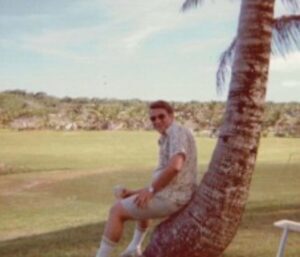 Ken relaxing during his second deployment to Guam
Ken relaxing during his second deployment to GuamFewer flights meant spending less time conducting maintenance and more time training. It also meant Ken had more time for other pursuits, especially off duty. Specifically, he could visit his family in Otsego now that they were only five hours away. He also got married and subsequently welcomed his daughter, Stephanie, into his life in 1972. Then, after U.S. participation in the Vietnam War ended in 1973, he again deployed to Andersen AFB in Guam, this time to help B-52 maintenance teams transition from their wartime readiness to meet peacetime and Cold War needs. He returned to Wurtsmith AFB at the end of the three-month deployment. After his first marriage ended in divorce, Ken met Colette McArdle on a blind date, and they were married in April 1975. The couple had their first son, Andrew, later that same year.
After spending seven years at Wurtsmith AFB and promoting to staff sergeant (E-5), Ken transferred with his family in June 1977 to Ellsworth AFB near Rapid City, South Dakota. Ken reported to the 28th Field Maintenance Squadron, although this time with a different role. Instead of working on hydraulics systems himself, he served as the field training instructor teaching the squadron how to maintain the hydraulics systems for the B-52 model H, which the base’s operational squadrons were just beginning to fly, and the KC-135A inflight refueling tanker aircraft, which also operated from the base.
The biggest challenge Ken faced at Ellsworth did not come from work, but from the extreme South Dakota winters. At times, the chill factor reached seventy-five degrees below zero, making it impossible to work on the planes parked on the tarmac. At other times, maintenance teams could work for only twenty minutes before having to warm up in their vehicles parked alongside the planes. Sometimes, just getting to the base proved difficult because of the heavy snows the area received. Ken and his family lived five miles off-base in Air Force housing at a de-activated NIKE missile site, accessible by a single road from the base. Until base plows cleared snow from the road, Ken and the other families living at the site were trapped. In fact, the site was so isolated that Ken’s backyard was designated as a helicopter landing zone in the event the Air Force needed to deliver food and other supplies to snow-stranded families. One thing the snow did not stop, however, was Ken and Colette having their second son, Josh, in 1981.
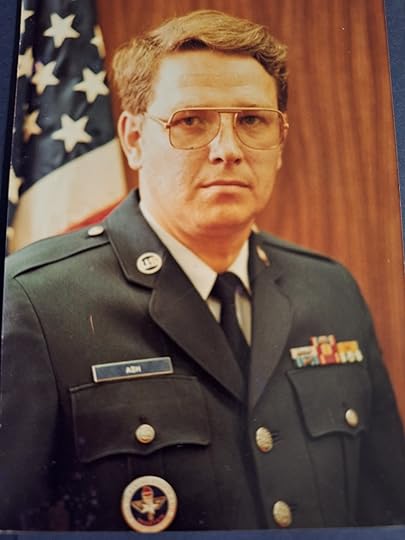 Technical Sergeant Ken Ash at Hahn Air Base in West Germany
Technical Sergeant Ken Ash at Hahn Air Base in West GermanyKen promoted to technical sergeant (E-6) at Ellsworth AFB and then transferred to Field Training Detachment 910 at Hahn Air Base in West Germany in 1983. This time, Ken taught how to repair and maintain the hydraulics systems on F-16 jet fighter aircraft, using the vast experience he’d gained working on similar systems for the B-52. The tour proved a great opportunity for Ken’s family, as they lived off-base in the small town of Gösenroth, immersing themselves in German culture every chance they could. Not only did the two boys learn to speak German, but the entire family also traveled throughout West Germany, as well as to Luxembourg and France.
In 1986, Ken returned to working on B-52s, this time as part of the 2nd Field Maintenance Squadron at Barksdale AFB in Shreveport, Louisiana. He remained there until July 31, 1987, when he retired from the Air Force after twenty years of service.
With his Air Force career behind him, Ken and his family moved to Florida, where he followed in his father’s footsteps and began working in the auto parts business. Wanting to be closer to family, they moved again in 1989 to Springfield, Illinois, where Ken continued working in the auto parts industry. He retired in 2014, and he and Colette now enjoy spending time with their many grandchildren and great grandchildren. Ken is also a member of AMVETS and is a life member of the Veterans of Foreign Wars (VFW).
Voices to Veterans is proud to salute Technical Sergeant Kenneth Ash, U.S. Air Force (Retired), for his twenty years of distinguished service to our country. Volunteering to serve during time of war, he helped save American lives in Southeast Asia by keeping B-52 bombers ready to fly missions in support of U.S. and allied ground troops. He similarly helped keep America safe during some of the hottest days of the Cold War by maintaining the operational readiness of the U.S. strategic bomber force. We thank him for all he has done and wish him fair winds and following seas.
If you enjoyed Ken’s story, please sign up for the Voices to Veterans Spotlight monthly newsletter by clicking here. Once each month, you’ll receive a new written veteran’s story directly in your mailbox. Best of all, it’s free and you can unsubscribe at any time.
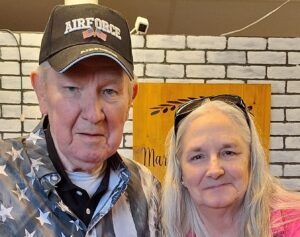 Ken and Colette Ash
Ken and Colette Ash The post Technical Sergeant Kenneth Ash, U.S. Air Force (Retired) – Twenty Years of Keeping B-52s Flying first appeared on David E. Grogan.
March 19, 2025
Master Sergeant Shawn Miller, U.S. Air Force (Retired) – Serving in the Iraq War and Across the Globe
When we make choices in life, we have no way of knowing how they will play out. A door that opens to paths in one direction may foreclose others and lead us to places we could not possibly have foreseen. When Master Sergeant Shawn Miller joined the Air Force, he had never even flown in an airplane before. Twenty-three years later, he’d served in far-off places around the world doing everything from refueling aircraft in the Honduran jungle to collecting intelligence in war-torn Iraq. Few can match the breadth and variety of his experience, which included investigating murder cases and augmenting presidential security teams. All this stemmed from his single decision to join the Air Force in 1991.
Shawn was born in 1973 and raised in Pontiac, Michigan. He attended Pontiac Northern High School but did not like school. Feeling added pressure from a chaotic family situation, he set his sights on graduating as soon as possible and getting out of Pontiac. He did two things to make that happen. First, he took extra classes to enable him to graduate early. Second, in November 1990, he decided the military would be his ticket out, so he visited a recruiting station.
With Operation Desert Shield underway since August 1990 and U.S. forces pouring into the Middle East in preparation for evicting Iraq’s invading army from Kuwait, military recruiters were eager to snag new recruits. However, when Shawn visited the recruiting station, only the Air Force recruiter was in the office. Shawn didn’t wait for the others to return. With his father’s written permission because he was only seventeen, Shawn enlisted in the Air Force for four years.
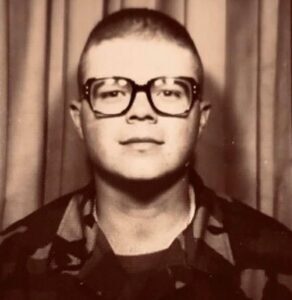 New recruit Shawn Miller at basic training
New recruit Shawn Miller at basic trainingOnce Shawn signed the enlistment papers, life began to move at lightning speed. He graduated from high school in January 1991 and reported for active duty at the Detroit Military Entrance Processing Station (MEPS) on February 5. After passing his final physical and taking the oath of enlistment, Shawn and other Air Force recruits like him flew to San Antonio, Texas, for basic training at Lackland Air Force Base (AFB). They arrived at night after a rough flight from Detroit. As they waited for instructions on what was to come next, they heard the clicking steps of someone with metal taps on their shoes approaching in the dark. By the time the hulking drill instructor finally arrived, Shawn and the other recruits were already intimidated. The drill instructor screamed at the group for the next thirty minutes, making sure they fully understood what they were in for.
Still just seventeen, Shawn felt unprepared for the coming ordeal. Shawn’s recruiter had told him nothing about what to expect at basic training or how to prepare, likely because ongoing Desert Storm operations had distracted him. Shawn also found himself on the bottom rung of every ladder because he was the youngest person in his training flight. That soon translated into him being assigned to do the laundry of his fellow recruits. Every few days, he had to collect mesh laundry bags from every recruit in his training flight. Each bag had a recruit’s name on it and was filled with underwear, t-shirts, and socks. Shawn took the bags to the laundry and threw them into the washers and driers, returning them to their owners at the end of the day. He was, at least, able to socialize at the laundry with the other recruits stuck with the same duty, which made the drudgery pass a little more quickly.
Although Shawn became an expert at doing everyone else’s laundry, he could not master folding his own t-shirts into the required twelve-inch by twelve-inch squares. He could, however, polish boots to perfection. Accordingly, he soon learned to swap shirt folding duties with other recruits in return for polishing their boots. With this arrangement in place, he sailed through to graduation on April 1, 1991.
Now officially an airman basic (E-1), Shawn reported to Fuels Journeyman Technical School at Chanute AFB in east central Illinois. There he learned the basics of fuels management, including fuel handling, delivery, storage, quality control, and safety. He trained with aviation fuels, as well as the liquid oxygen used by flight crews and the liquid nitrogen required by various aircraft systems. He learned how to deliver fuel to aircraft, vehicles, and generators, covering everything except in-flight refueling. He also practiced basic maintenance on fuel-related equipment, so he could keep fuel operations up and running.
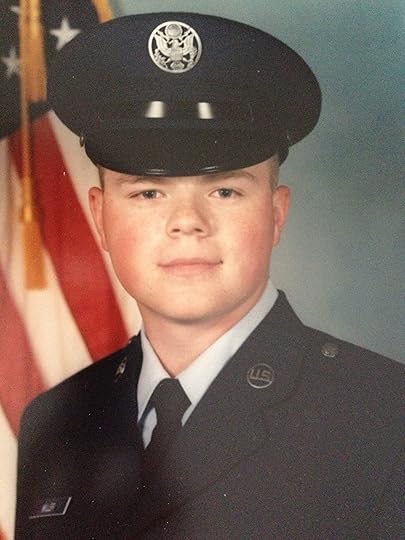 Shawn Miller at the end of basic training
Shawn Miller at the end of basic trainingAs one of the youngest members of his technical school class, Shawn again found himself at the bottom of the food chain. Not wanting to stay in that position forever, he applied for and was selected to attend “rope school,” where he learned about becoming an effective leader. Upon completion, he wore a red braided cord loop around the left shoulder of his uniform, signifying he had assumed additional leadership duties and responsibilities for the remainder of his time at the school. His leadership initiative would define him for the rest of his career.
Shawn graduated from Fuels Journeyman Technical School in late May 1991. Afterwards, he reported to his first operational command, the 375th Supply Squadron, at Scott AFB just east of St. Louis. The squadron put him to work delivering aviation fuel to the base’s C-9 medevac jets, C-21VIP Learjets, and C-12 turboprop passenger aircraft. Once he acquired the on-the-job fueling experience he needed, his responsibilities shifted to fuel storage. In addition to handling aviation-specific requirements like jet fuel and liquid oxygen and nitrogen, he also managed fuels for the base’s official government vehicle gas station. He enjoyed the work and did well, promoting to airman (E-2) in late 1991.
In July 1992, an opportunity arose Shawn could not pass up. Joint Task Force-Bravo (JTF-B), which conducted counterdrug and other missions from Soto Cano Air Base in central Honduras, needed someone with Shawn’s qualifications, and he raised his hand. He reported to JTF-B in July and, together with one other fuels management specialist, assumed responsibility for fueling all U.S. aircraft operating from the base. As missions took place around the clock, he was on call to refuel aircraft twenty-four hours a day, seven days a week. His duties took him all over Honduras, delivering fuel by truck to wherever it was needed. He spent most of his limited free time on base because of ongoing civil unrest, but he did manage to visit the Honduran capital, Tegucigalpa. He also promoted to airman first class (E-3) during his time at JTF-B.
Shawn returned to the 375th Supply Squadron at Scott AFB in November 1992. He resumed his fuels storage duties until another temporary duty opportunity arose in August 1993. This time it involved refueling operations for U.S. aircraft making stops at an air base in Egypt as part of an operation known as Coronet Aspen. Shawn was one of two fuels management specialists, together with a contingent of approximately 120 other personnel, who helped process, repair, and ship military equipment after the end of the Gulf War. Although aircraft arrived at the base infrequently, Shawn had plenty to do helping prepare the military equipment for transport. As with JTF-B, he was always on call and incredibly busy, but he loved the people he worked with and the esprit de corps. He was also selected as Airman of the Month in December 1993 and promoted to senior airman (E-4), helping make the Coronet Aspen assignment in Egypt one of the best of his career.
In January 1994, Shawn again returned to the 375th Supply Squadron. However, given his previous experience at the squadron and the knowledge he gained during his temporary assignments, he shifted jobs to learn the accounting side of fuels management. This included documenting fuel orders and deliveries, processing fuel billing, and determining daily fuel gains and losses. The assignment made clear squadron leadership had confidence in his abilities and saw him as a career candidate for the Air Force’s fuel management program. During this time, Shawn also met and married his first wife. She brought a daughter from a previous relationship into the marriage, and they had a daughter of their own in 1994.
In December 1995, yet another temporary duty opportunity arose, this time in Kosovo. En route to the assignment, Shawn stopped at Rhein-Main Air Base near Frankfurt, Germany. When base personnel learned Shawn had experience in fuels accounting, they made the necessary arrangements to retain him at Rhein-Main where his expertise would help account for fuel consumption in the NATO-led Kosovo peacekeeping effort. He remained at Rhein-Main supporting Kosovo operations until March 1996, when he again returned to his permanent command at Scott AFB.
Shawn detached from the 375th Supply Squadron in August 1996 and reported to the 36th Supply Squadron at Andersen AFB on Guam. The fuels operations at Andersen were much larger than those at Scott, so Shawn had a broader range of responsibilities. However, his principal duties still involved fuels accounting. He did this until April 1999, when he was again given temporary additional duty orders, this time to Prince Sultan Air Base in Saudi Arabia. There he provided fuels management support to Operation Southern Watch, which involved U.S. and coalition aircraft enforcing a no-fly zone over southern Iraq. Although his work at the air base, colloquially known as “Al’s Garage,” was challenging and he promoted to staff sergeant (E-5) while there, he was happy when his four-month rotation came to an end in August, and he returned to his family and command in Guam.
Shawn’s career took a dramatic turn in a new direction once he was back in Guam. While in Saudi Arabia, he had spoken to a special agent working for the Air Force Office of Special Investigations (AFOSI), which was responsible for investigating criminal allegations involving Air Force personnel and conducting counterintelligence operations. This sounded more interesting than a career in fuels management, so Shawn applied to become a special agent. He was accepted after undergoing a battery of tests, background checks, and personal interviews. Before he could begin his new duties, however, he had to complete federal law enforcement training at Andrews AFB just outside of Washington, D.C. Accordingly, he detached from the 36th Supply Squadron on September 9, 2001, and arrived with his family—which now included a son born in 1999—back in Illinois on September 10. The next day, terrorists attacked the World Trade Center and the Pentagon, forever changing the lives of all U.S. citizens and the job responsibilities Shawn was about to assume.
Unable to fly to Washington immediately after the attack, Shawn drove to Andrews AFB to begin his special agent training, as did the majority of the other fifty people in his class. The training was the toughest he encountered during his Air Force career, both mentally and physically. He also had to learn many new skills, including becoming proficient with a pistol—something he had never fired before. He completed the training in December 2001, earning the title of special agent, although he also retained his staff sergeant rank.
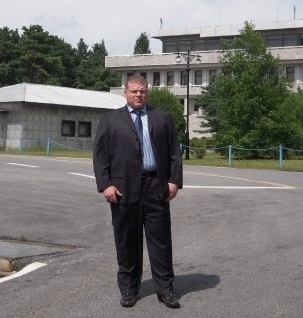 Special Agent Shawn Miller
Special Agent Shawn MillerWith the law enforcement training under his belt, Shawn drove to Illinois to pick up his family. From there, they traveled to McConnell AFB in Wichita, Kansas, where Shawn was assigned as the criminal division chief for AFOSI Detachment 321 beginning in January 2002. He gained significant experience during this assignment, conducting some of the largest drug busts in base history and working on felony cases involving allegations that included murder, kidnapping, sexual assault, and child pornography. His investigations proved so thorough that most often the alleged perpetrators pled guilty at trial, while those who did not were convicted. Shawn worked for Detachment 321 until January 2003, when he transferred back to Scott AFB in Illinois to be closer to his wife’s family.
At Scott, Shawn was assigned to AFOSI Detachment 301. However, instead of investigating criminal cases as he had at McConnell, he did counterintelligence work. This AFOSI responsibility had received additional emphasis and resources since the September 11, 2001, terrorist attacks as part of an effort to keep Air Force assets safe from would-be attackers anywhere in the world. Accordingly, Shawn’s primary responsibility was to collect intelligence from around the base and other available sources and make threat assessments so the base and local authorities could take any necessary protective actions. When the Iraq War started in March 2003, his job became even more critical.
A few months into the war, Shawn received orders to do his part in Iraq. He reported to the Coalition Provisional Authority (CPA)-North in Erbil. The CPA governed Iraq after coalition forces defeated the Iraqi military and remained in place until an interim Iraqi government took over in post-Saddam Hussein Iraq. To govern more effectively at the local level, the CPA established four regions, with CPA-North having responsibility for the primarily Kurdish region in northern Iraq.
Beginning in September 2003, Shawn worked as one of seven special agents collecting intelligence from across the region. They did this by driving to the region’s cities, towns, and villages and meeting with people who could provide them with relevant information. They then wrote reports describing what they had learned and provided the reports to military planners so their findings could be used to minimize the risk to coalition forces conducting missions in the area. They also met with military and other officials to brief them on and have them acknowledge potential threats to ensure the leaders made appropriate arrangements to protect themselves as they executed their responsibilities.
During the six months Shawn served in Iraq, he drove over 15,000 miles, covering not only Erbil, but also hotspots like Tikrit, Kirkuk, and Mosul. Instead of driving military vehicles, he and his team used rental cars and Chevy Suburbans, although one of the Suburbans was armored to provide at least some protection from any Improvised Explosive Devises (IEDs) hidden along the roads and from small arms fire from Iraqi insurgents. More than once, Shawn and his group came under fire, and on one occasion an armored vehicle was disabled by a bullet that severed its fuel line. Because they were repeatedly exposed to enemy fire, Shawn and the other members of his team received the combat action ribbon at the end of their tours. As Shawn left Iraq, he felt confident he had made a difference there by helping protect U.S. and coalition lives.
Shawn returned to Scott AFB in February 2004 and reported to AFOSI Region 3. This command—one echelon above the two AFOSI detachments he had previously worked with—was responsible for providing counterintelligence support to the Air Mobility Command (AMC) headquarters located on Scott AFB and its vast array of squadrons and transport aircraft operating around the world. As Shawn was one of the first special agents to bring warfighter experience to Region 3, he was able to help drive its efforts to provide more robust counterintelligence support to the commands he advised. As a result, he promoted to staff sergeant (E-6) while at Region 3. Unfortunately, while Shawn’s military career thrived, his marriage did not, and he divorced in July 2004.
In October 2005, Shawn transferred to AFOSI Detachment 623 on Misawa Air Base near the northern tip of Japan’s Honshu Island. He spent three years there as the Criminal Division chief, investigating criminal allegations against U.S. military members, their dependents, and other U.S. personnel assigned to the base. He worked alongside his Naval Criminal Investigative Service (NCIS) and Japanese counterparts, investigating two major crimes against children and numerous drug-related offenses.
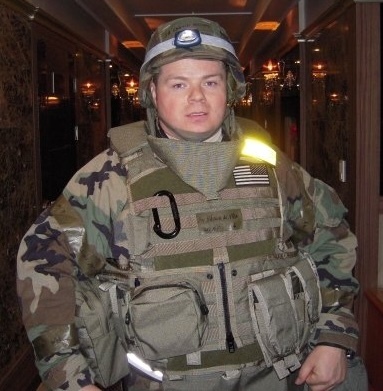 Shawn Miller training in Korea
Shawn Miller training in KoreaAfter his tour in Misawa, Shawn transferred to AFOSI Detachment 614 at Yongsan Air Base in Seoul, South Korea. He was one of three special agents liaising directly with Korean law enforcement officials in furtherance of counterterrorism, counterintelligence, anti-fraud, and force protection efforts. When U.S. government VIPs needed protection, Shawn served on their protection details. In fact, given his close relationship with South Korean law enforcement officials, he augmented the teams planning and providing protection for President Barrack Obama during two of his visits to South Korea. He also met a Korean woman, Eun-Kyung, and they married in 2010, making Shawn’s time in Korea particularly special. To top it off, Shawn promoted to master sergeant (E-7) while there.
Shawn and Eun transferred back to AFOSI Region 3 at Scott AFB in 2011, where Shawn became the counterintelligence lead. In this capacity, he served as the supervisor for all the AFOSI detachments covering the AMC and provided detailed counterintelligence reports to its senior leadership. Two years after his and Eun’s daughter was born in 2012, Shawn retired from the Air Force effective April 1, 2014.
Once a civilian, Shawn moved with his family to nearby Springfield, Illinois, where he worked for one year with the Illinois Office of the Executive Inspector General. He then transitioned to managing Walgreens stores for four years before finally becoming an independent insurance broker. Outside of work, he serves veterans as the commander for American Veterans (AMVETS) Post 94, a trustee for Veterans of Foreign Wars (VFW) Post 11463, and a member of the American Legion. In January 2024, he began serving as chairman of the independent board overseeing the Veterans Assistance Commission of Sangamon County. The commission is the unit of county government responsible for assisting veterans and their families as mandated by the Illinois Military Veterans Assistance Act. Shawn’s job as a board member is to require the commission and the county to fulfill the statutory mandate.
Voices to Veterans is proud to salute Master Sergeant Shawn Miller, U.S. Air Force (Retired), for his twenty-three years of distinguished service to our country. Whether assuming extreme personal risk during the Iraq War to ensure other U.S. and coalition servicemembers remained safe, or seeking justice for victims of the most serious felony crimes, Shawn dedicated his life to serving others. Even after his military career, he continues to serve veterans in his community by helping them get the benefits and assistance they need. We thank him for all he has done and wish him fair winds and following seas.
If you enjoyed Shawn’s story, please sign up for the Voices to Veterans Spotlight monthly newsletter by clicking here. Once each month, you’ll receive a new written veteran’s story directly in your mailbox. Best of all, it’s free and you can unsubscribe at any time.
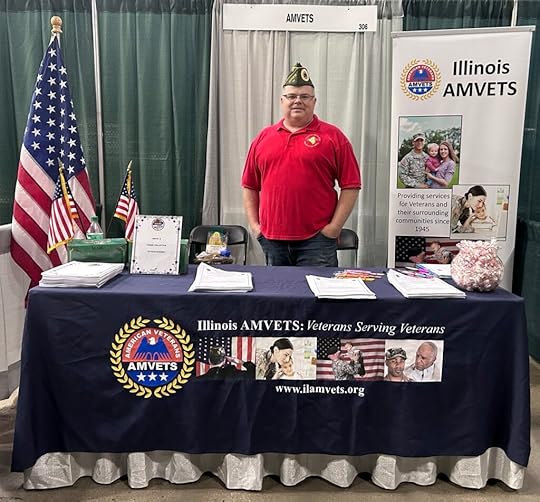 Shawn Miller at an Illinois AMVETS display
Shawn Miller at an Illinois AMVETS display The post Master Sergeant Shawn Miller, U.S. Air Force (Retired) – Serving in the Iraq War and Across the Globe first appeared on David E. Grogan.
February 19, 2025
Major Richard N. Walker, U.S. Air Force (Retired) – Engineering the Cutting Edge of Flight
The U.S. military requires many people with varying talents to sustain its position as the greatest fighting force on Earth. In addition to the soldiers, sailors, airmen, and Marines engaging with the enemy on the field of battle, it needs countless others in support roles giving those on the front lines what they need to fight and win. It needs cooks and bakers, mechanics and builders, doctors and nurses, truck drivers and training instructors, just to name a few. Another key role is that of the engineer who helps design, develop, test, produce, and provide the technology the warfighters need to do their jobs. That is where Major Richard N. Walker, U.S. Air Force (Retired), steps in. His work over two decades in uniform has given U.S. forces a decisive edge in both combat and the deterrence of war. He is one of the unsung heroes in the success of the U.S. military.
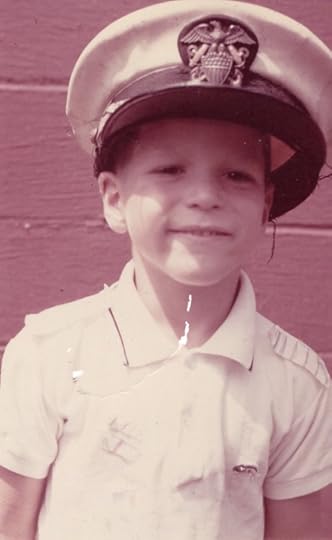 Rich Walker wearing his father’s Navy uniform hat
Rich Walker wearing his father’s Navy uniform hatRich’s father worked as a system engineer for the U.S. Steel Corporation after graduating from Stanford University in 1942 and serving in the Navy during World War II. His mother earned her bachelor’s degree in physics from Bryn Mawr College outside of Philadelphia—she was the only physics major in her class. After working one year at Bell Labs, she helped a friend move to San Francisco, where she met Rich’s father, and they were married. The couple had two children together in California before settling permanently in Pittsburgh, Pennsylvania, where Rich and his sister were born in 1960 and 1958 respectively.
Rich attended Shady Side Academy, a private school located in the Pittsburgh suburbs. The school mandated sports during high school years, so Rich played soccer and tennis and shot for the rifle team. During his senior year, he also picked up backpacking, an activity he continues to enjoy. To keep money in his pocket, he mowed lawns for people in his neighborhood.
Rich graduated as the salutatorian of his class in June 1979. With the final moon walk just seven years before and space shuttle flights already on the horizon, Rich wanted to pursue a career in aerospace engineering so he, too, could be part of exploring space’s new frontiers. Given that goal, he narrowed his college choices to two universities with outstanding aerospace engineering programs: Stanford University (his father’s alma mater) and the University of Colorado Boulder. To help pay for his schooling, Rich decided to apply for a Reserve Officer Training Corps (ROTC) scholarship, where his education expenses would be covered in return for a military service commitment upon graduation.
The decision to apply for an ROTC scholarship made his college selection decision both easier and more difficult at the same time. In the aftermath of the Vietnam War, Stanford had terminated its ROTC program, so Rich would have to find another way to pay to attend. In contrast, Colorado had Navy and Air Force ROTC programs, both of which he was interested in. Because his father was a Navy veteran, Rich not surprisingly inquired into the Navy’s program first. When the recruiter asked Rich what he wanted to do, he said he wanted to work with airplanes and spacecraft. When the recruiter replied that the Navy put its new officers on ships, Rich headed for the Air Force recruiter. He told Rich working on planes and spacecraft would be no problem, so Rich applied to the Air Force ROTC program and was accepted.
Even with a way to pay for his education at Colorado assured, Rich was still undecided about which university to attend. Although Colorado had a top ten aerospace program, there was something about a degree from Stanford that still beckoned to him. Then he visited a friend’s house and spoke with the friend’s father, who was a judge. The judge told him to take the ROTC scholarship at Colorado and get an advanced degree from Stanford down the road. That advice resonated with Rich, and he began classes at Colorado in the fall of 1979.
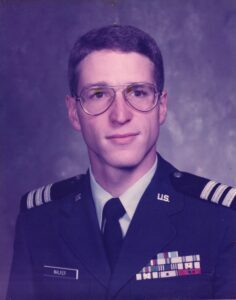 ROTC Cadet Rich Walker
ROTC Cadet Rich WalkerDuring Rich’s senior year, retired Brigadier General Robin Olds visited Rich’s ROTC unit and spoke with the officer candidates. General Olds was a storied fighter pilot who fought in World War II and the Vietnam War. He was also a triple ace, having shot down a combined total of seventeen enemy aircraft in the two wars. He told Rich and the other ROTC students that their job was to prepare for war. Moreover, he told them that if war comes, they need to do everything they could to participate in it because it might be their only chance to do what they’d been trained to do. The general’s advice reminded Rich of his father, who had volunteered for sea duty onboard the heavy cruiser USS Los Angeles (CA-135) during World War II after initially being assigned to work in shipyards. The general’s words and his father’s example guided and motivated Rich for the rest of his Air Force career.
Rich graduated from the University of Colorado Boulder with a bachelor’s degree in aerospace engineering in May 1983. Because he was a distinguished graduate for his ROTC class, he also received a commission as a second lieutenant in the regular Air Force, while his ROTC classmates received their commissions in the Air Force Reserve. As he did not have to report to his first duty station until September 1983, he spent the summer visiting friends.
In September, Rich reported as ordered to the Air Force Rocket Propulsion Laboratory located on Edwards Air Force Base (AFB) in the California desert. The lab was the hub for research and testing of the rocket engines for U.S. intercontinental ballistic missiles (ICBMs), space launch vehicles, and air-to-air missiles. In the 1960s, it was also the site for testing the rocket engines for NASA’s Apollo space program. Rich’s initial assignment was as a general acquisition research engineer working on solid propellant rocket motor design concepts for ICBMs, strap-on booster rockets, and other space vehicle launch systems. The experience proved extraordinary because he served alongside senior engineers who had worked on the Apollo rocket program. As those senior engineers retired, Rich and other young engineers stepped into their roles, gaining significant practical and project management experience that would otherwise have taken years to obtain. They also developed a strong esprit du corps, all motivated by their common efforts in support of U.S. missile technology and ultimately nuclear détente with the Soviet Union.
Rich promoted to first lieutenant in July 1985. Around this time, he participated in a paint ball fight between his group of junior officers from Edwards AFB and another group from the Los Angeles AFB. Rich was shot by a second lieutenant from Los Angeles in charge of the work surrounding a solid fuel rocket booster for a Titan missile designated to launch large satellites. Six months after that encounter, that officer called Rich about attending a contractor meeting in January 1986 to discuss using the O-ring seals from the space shuttle boosters on the Titan rocket, whose single O-ring seals appeared to be eroding based on recovered boosters. When the program’s colonel asked Rich and the expert with him what they thought of the proposal, they replied that while they were not familiar with the space shuttle O-rings’ performance, they did know that the Titan had not suffered a seal failure in over 100 launches. Moreover, experience with testing the Titan’s type of seal on air-to-air missiles indicated the contractor’s theoretical analysis supporting using the space shuttle O-rings was not a good predictor of success. Accordingly, they recommended against the change.
After the meeting, the colonel accepted their recommendation. One week later, an O-ring failure on the Space Shuttle Challenger destroyed the vehicle shortly after launch, killing all on board. From that point on, Rich’s judgment and recommendations received added weight among his colleagues. He also took on additional responsibility because his boss was called away for a year to assist with the Challenger mishap investigation.
Throughout the time Rich spent working on space-related projects, he served as one of two officers leading research efforts for Small ICBMs—mobile ICBMs that were harder to locate and destroy than their siloed counterparts—and next generation ICBM variants. Because of his ICBM expertise, he was also selected as the ballistic missile research planner on the lab commander’s staff during his final year at the lab.
After mastering the basics of being an Air Force aerospace engineer at the Rocket Propulsion Laboratory, Rich transferred to the Air Force Institute of Technology (AFIT) at Wright-Patterson AFB in Dayton, Ohio, to pursue his master’s degree in astronautical engineering with a specialization in structures. He sought the change away from rocket engines because he had observed their development slow over the past few years and wanted to be at the forefront of cutting-edge research. In addition, President Ronald Reagan’s Strategic Defense Initiative (SDI), which at the time was garnering significant attention and effort, envisioned employing numerous structures in space to shield the United States from ballistic missile attack, so Rich wanted to study controlling space structures.
Rich arrived at AFIT in June 1987 and promoted to captain in July. Over the course of the next eighteen months, he took eighty-eight credit hours of engineering courses covering structural dynamics, structural analysis, and passive and active damping (i.e., reducing vibrations). He also completed his master’s thesis, earning his master’s degree in astronautical engineering (structural dynamics/analysis) in December 1988. As if that wasn’t enough, he graduated first in his astronautical engineering class. In fact, he so impressed the faculty with his work, they invited him to return to AFIT to teach about control and damping systems. First, though, he had to earn his Ph.D. over the next three years—a very ambitious timeline given it usually took five years to complete. On the positive side, he would get to do so at Stanford University, fulfilling the advice he received years before. Better yet, the Air Force would pay for the cost of his studies.
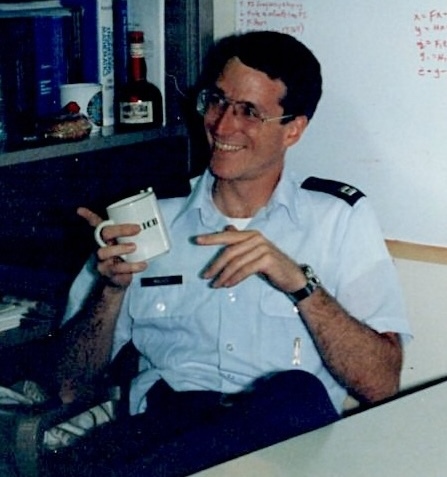 Rich Walker at Stanford University
Rich Walker at Stanford UniversityUnfortunately, the timing of Rich’s arrival at Stanford in January 1989 made achieving his Ph.D. within the allotted timeframe extremely difficult. First, the damping program courses he needed were only offered every other year, so he could not take them in time to complete his work. Second, because he started in January, he missed all the fall quarter courses necessary to prepare for his oral boards that were already just a few months away. When he took the boards, he passed his fluid and structural mechanics boards, but not the board covering dynamics and control because he had not taken Stanford’s basic control classes. He took those classes in the fall and passed the related board then, but by then he was falling behind the three-year timeline.
Although Rich might have been able to catch up with the timeline, an issue arose with his doctoral thesis that proved insurmountable. He and his faculty advisors had settled on a theoretical topic for the paper, and Rich began working on it. Then, in 1991 as academic databases started coming online, Rich did a search and found that a research team in Australia had already covered his topic. That meant Rich would have to find a new topic and complete the associated research, and there simply was insufficient time. He asked for an extension given the confluence of the circumstances he faced, but his request was denied. Accordingly, he returned to teach at AFIT in January 1992 without a Ph.D. Despite these hurdles, Rich still wrote a thesis while working full time over the course of his next two assignments, earning the Degree of Engineer, Aeronautics/Astronautics (Dynamics and Control) in September 1994. Still, it was not the Ph.D. the Air Force expected. This shortfall would have ramifications later in Rich’s career.
When Rich returned to AFIT in 1992, he joined the faculty as an instructor and, instead of teaching about rocket and space structures given the experience he gained during his first assignment, taught courses in aircraft dynamics, aircraft handling qualities, and optimization theory. Rich found the ground in his new areas more fertile, especially with President Reagan’s SDI now in the rear-view mirror. As a result of teaching at AFIT, Rich became proficient in the engineering for aircraft performance, which proved timely.
In the summer of 1993, the military dean at AFIT counseled Rich that he could not get promoted at AFIT without his Ph.D. and released him to find a job with one of the acquisition programs located on Wright-Patterson AFB. Finding a position proved difficult because in the peace dividend years after the fall of the Soviet Union in December 1991, new developments were few. Fortunately, the chief engineer for the Joint Primary Aircraft Training System (JPATS) needed someone with depth in aircraft performance and system design, and Rich got the job.
The objective of the JPATS program was to produce the new training aircraft to replace the Air Force T-37 Tweet and the Navy T-34 Mentor basic pilot training planes. Rich’s job was to serve as a system certification engineer, initially helping write and evaluate the contract specifications for the plane. Once the specifications were written, Rich worked with the potential bidders and the Federal Aviation Administration (FAA), answering questions and making sure to maintain a level playing field for all competitors so no one had an unfair bidding advantage. He performed these responsibilities with skill and integrity—any misstep could have resulted in a challenge to the acquisition and forced the project to be re-bid. He also developed aircraft certification requirements for source selection, evaluated competitor proposals, briefed the Air Force acquisition executive, won acceptance of certification and maintenance plans with the FAA, and became a recognized expert in FAA aircraft certification procedures. The result of his efforts was the Air Force and Navy’s new training aircraft, the T-6 Texan II, which is still in use for basic pilot training today.
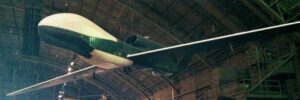 Global Hawk Prototype #1 hanging in the U.S. Air Force Museum
Global Hawk Prototype #1 hanging in the U.S. Air Force MuseumIn recognition of Rich’s outstanding performance, he promoted to major in 1995. Also in recognition of his work, he was asked by an officer he previously worked with to work at the Defense Advanced Research Project Agency, known as DARPA, as a detailee from the Reconnaissance System Program Office at Wright-Patterson AFB. Rich took the job and reported to the High Altitude Endurance Unmanned Aircraft System Joint Program Office of DARPA in Arlington, Virginia, in March 1996. There he served as the deputy integrated project team lead for a groundbreaking reconnaissance drone program known as Global Hawk, although he also spent much of his time in San Diego at the contractor facility building the drone prototype. The drone was designed to supplement the aging U-2 spy plane and could fly 3,000 nautical miles, loiter for up to 24 hours at 60,000 feet, and return home. Rich was responsible for the drone’s structural design, analysis, and testing, including a bending test of the drone’s wing which was made of a new composite material. He also oversaw aircraft subsystem installation and airframe integration. The Global Hawk program proved its worth when the prototype was employed during the wars in Afghanistan and Iraq. Soon, all the combatant commanders wanted to employ the drone in their theaters of operation.
U.S. combatant commanders weren’t the only ones who recognized Global Hawk’s success. In 2000, the program won the Collier Trophy, a prestigious annual award for the greatest achievement in aeronautics or astronautics relating to improving demonstrated performance, efficiency and safety. Rich attended the awards dinner as part of the DARPA and Air Force development team. In addition, the Global Hawk prototype Rich worked on now hangs in the U.S. Air Force Museum at Wright-Patterson AFB in Dayton, and the U.S. and other countries still use the production version, formally known as the RQ-4 Global Hawk.
After a year of working on Global Hawk, Rich shifted to another DARPA drone program known as the RQ-3 DarkStar. This time he served as the Deputy Program Manager, overseeing contracts with the Lockheed Martin Corporation and Boeing to jointly develop a stealth surveillance drone. Rich joined the project after the first prototype crashed, with his job being to identify and fix the problems in the drone’s specifications and help make it operational worldwide. The project faced numerous hurdles, not the least of which was the inability of the Lockheed and Boeing teams to work together. In addition, the aircraft layout—like a flying Hershey bar with only a small forward fuselage—made it difficult to control on takeoff. There were other problems, too. For example, the initial design of the drone did not include navigation lights, which Rich flagged as a non-starter noting they were required and all other U.S. stealth aircraft had them. The companies’ engineers eventually added the lights, but not before labeling them “Walker’s folly.” Despite the contractors’ attempts to correct the other problems with the drone, by 1998 it became clear the DarkStar program was doomed. Accordingly, the Department of Defense shut down the program and transferred the remaining funding to the more successful Global Hawk program. Still, the Smithsonian Air and Space Museum on the National Mall displayed one of the RQ-3 DarkStar drones for several years before the museum was renovated, but the surviving test aircraft is still on display at the Air Force Museum in Dayton, Ohio.
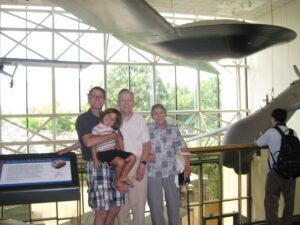 Rich Walker (left) holding his daughter and standing with his parents in front of a DarkStar drone hanging at the Smithsonian Museum
Rich Walker (left) holding his daughter and standing with his parents in front of a DarkStar drone hanging at the Smithsonian MuseumRich’s experience at DARPA was the best of his career. He had immense responsibility as part of a five-person government team working on national-level programs involving tens of millions of dollars. He even made it as a finalist for the Wright-Patterson AFB engineer of the year. Unfortunately, none of this was enough to overcome the Ph.D. missing from his resume. In fact, the chief military engineer at Wright-Patterson actually called Rich to his office and asked him to explain why he had not earned his doctoral degree. The final blow came when it came time to transfer to Rich’s next assignment. He had done so well at DARPA and been given such stellar performance reviews that he had a chance to be selected for promotion to lieutenant colonel. However, instead of allowing him to extend past his scheduled September transfer date so his current supervisors who knew him well could write his next promotion recommendation, he had to transfer on time to his new command where he would be the newest member of the staff and thus not likely to receive the promotion recommendation he needed. As a result, Rich did not select for lieutenant colonel.
Dismayed but not deterred, Rich learned that the National Reconnaissance Office (NRO) might be looking for someone with his qualifications. At the time, the NRO was just beginning to make its existence known to the public. Its function was to develop, launch, and employ space-based sensors in support of U.S. national defense; however, few people knew anything about the NRO or what it did. In fact, when the NRO asked Rich to interview for a job, he could not even be told what the job was because it was so highly classified. When he finished the interview, he was certain he did not get the job because he could not explain how his qualifications made him the best choice because he didn’t know what the job was. He later learned an NRO employee he met at Stanford had recommended him for the position, which he ultimately did not get. Still, he impressed his interviewers so much that they created a new position for him at the Signals Intelligence (SIGINT)/Low Earth Orbit System Project Office and brought him onboard the NRO in 1998.
Joining the NRO team proved difficult, especially during the first year, because people guarded information so closely. Rich started out as the Deputy Chief, Integration and Test for a new series of reconnaissance satellites. When his boss transferred, he became the Chief of Test and, later, the Chief Spacecraft System Engineer, where he evaluated production and design issues, recommended resolution plans, and implemented a requirement verification/waiver process for the satellite project. This helped with his integration into the team because his position demanded he be included in the program manager’s inner circle. When the satellite project fell behind schedule, Rich and his team of engineers began shiftwork to provide engineering oversight twenty-four hours a day, seven days a week. As Rich was single, he scheduled himself for midnight and weekend shifts so others could spend time with their families during “normal” hours.
Rich’s work culminated with the launch of the satellite in September 2001. Rich directed a sixty-person team in Denver checking out satellite operations. Three days after the satellite launched, terrorists attacked the World Trade Center and the Pentagon. Rich found the launch particularly satisfying because the satellite was available to assist immediately after the United States had been attacked.
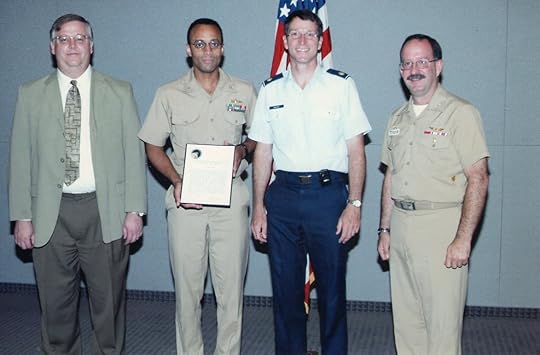 Rich Walker (second from right) being recognized as the NRO Officer of the Quarter
Rich Walker (second from right) being recognized as the NRO Officer of the QuarterWith the satellite operational, Rich began work on his second satellite project. When the program manager departed, Rich’s boss took over the position as the acting program manager. When he left, too, Rich became the acting chief of acquisition development, assuming an incredible amount of responsibility. His rise in the organization was so fast that during one meeting, the NRO head of finance turned to him and asked, “Who are you?” Rich responded, “I’m the acting acting chief of acquisition,” signaling with the two “actings” how turnover had propelled his ascent.
As the acting acquisition development chief, Rich was responsible for a multi-billion-dollar budget and directed the activities of 300 contractor and government engineers managing NRO’s top SIGINT satellite program. He remained in this position until a permanent chief of acquisition development from the Navy was named, and then he was designated as his replacement’s chief of staff in recognition of his vast knowledge and experience with most aspects of satellite manufacturing and testing. He stayed in this position for eighteen months until he retired from the Air Force in 2003 after twenty years of service. In recognition of his distinguished career and his contributions to the NRO, Rich not only received the traditional Air Force retirement ceremony, but his Navy boss also arranged for him to be “piped ashore” by a Navy boatswain’s mate as is done to honor retiring Navy officers.
Given all the experience Rich gained over his active-duty career, he did not have to search for a job after retiring—employers reached out to him. He settled on an offer from Airborne Technologies Inc., where he was employee number three. Rich was brought on as the senior system engineer and program manager, providing science and engineering technical support to classified government programs. In 2007, he shifted to developing an air-launched electric drone, which took him to places like Yuma, Arizona; White Sands, New Mexico; and China Lake, California, for flight tests. When L3 Technologies purchased Airborne Technologies Inc., Rich became a senior program manager focusing on unmanned aerial systems. He stayed in this position until he retired in January 2022.
As Rich reflected on his long career, he was drawn back to his time at Stanford University when the Gulf War broke out. All the Air Force graduate students with operational experience volunteered to serve in the war. All were denied, just like Rich’s father’s entire Stanford engineering class was counseled against taking combat assignments immediately after the attack on Pearl Harbor. Then as now, senior military leaders recognized engineers like Rich could make far greater contributions to the defense of the United States by developing the advanced systems the warfighters needed to fight and win wars. Recalling Brigadier General Robin Olds’ advice to do all he could to participate in a war should one break out, Rich came to understand that his war involved preparing the United States for potential conflict. He accepted that role knowing that his work helped maintain America’s superiority on the battlefield.
Voices to Veterans is proud to salute Major Richard N. Walker, U.S. Air Force (Retired), for his distinguished career in the research, acquisition, and development community. Always on the cutting edge, Rich assumed responsibility beyond his years and pushed the development of key defense technologies critical to warfighter training and operations. There is no doubt the systems Rich helped develop gave U.S. forces the tools they needed and saved American lives. We thank Rich for his twenty years of dedicated service and wish him fair winds and following seas.
If you enjoyed Rich’s story, please sign up for the Voices to Veterans Spotlight monthly newsletter by clicking here. Once each month, you’ll receive a new written veteran’s story directly in your mailbox. Best of all, it’s free and you can unsubscribe at any time.
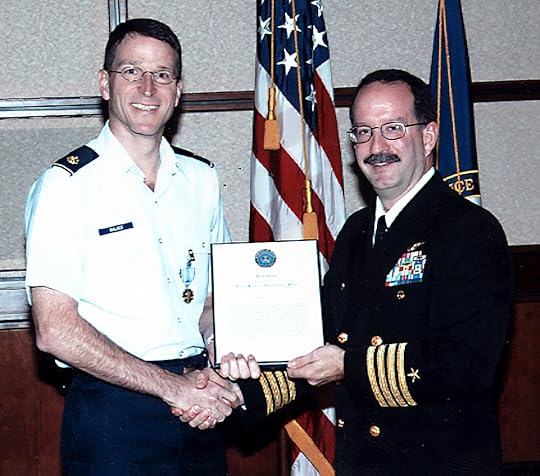 Major Rich Walker (left) at his retirement ceremony
Major Rich Walker (left) at his retirement ceremony The post Major Richard N. Walker, U.S. Air Force (Retired) – Engineering the Cutting Edge of Flight first appeared on David E. Grogan.



